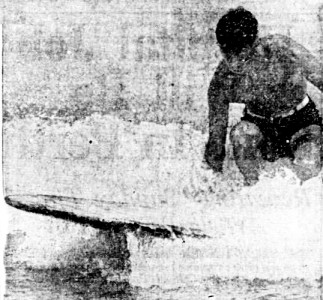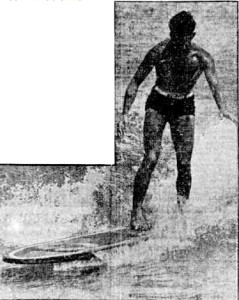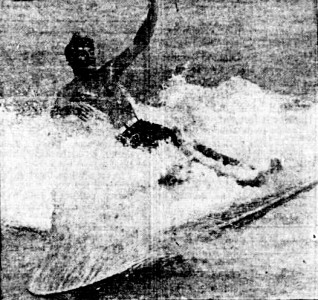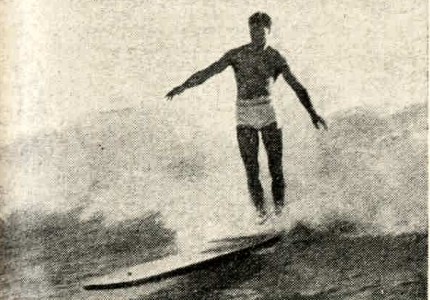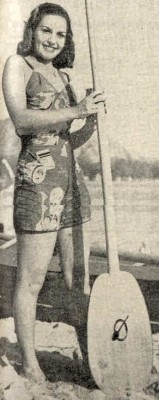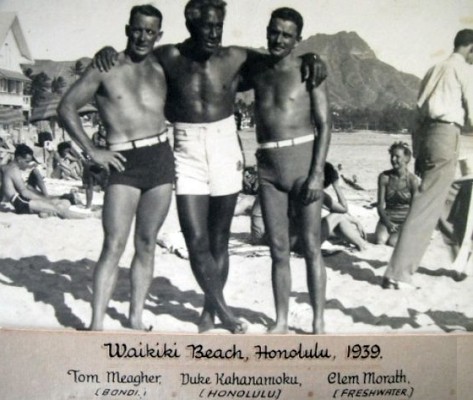surfreserch.com.au
 |
surfresearch.com.au
newspapers : 1939
|
Newspaper Extracts : 1939.
The Age
Melbourne, 2 January 1939, page
3.
On The
Beach At Lorne
Misses Vivian
Bartlett , Betty Jewel and Joan Smallhorn
ready for a tussle with
the surf.
Trove
1939 'On The Beach At Lorne', The Age (Melbourne,
Vic. : 1854 - 1954), 2 January, p. 3. , viewed 06
Jul 2016,
http://nla.gov.au/nla.news-article205970444
|
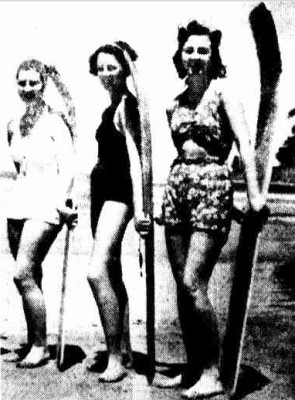
|
The Argus
Melbourne, 4 January 1939, page
3.
ENJOYING THE SURF
and the sun at Lorne.
Miss Mavis Trevorrow using her surf-board as a
shield against a fresh breeze.
|

|
The
Age
Melbourne, 4 January 1939, page
6.
HOLIDAY SCENES FROM VICTORIA'S SOUTHERN
COASTLINE
Betty and Edna
Humphrey carrying their surf board
to the beach at Torquay.
Trove
1939 'HOLIDAY SCENES FROM VICTORIA'S
SOUTHERN COASTLINE', The Age (Melbourne, Vic. :
1854 - 1954), 4 January, p. 6. , viewed 06 Jul
2016,
http://nla.gov.au/nla.news-article205964576
|
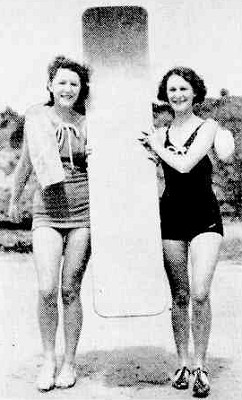
|
Construction
Sydney, 11 January 1939, page 8.
ADVERTISING
AUSTRALIA.
We illustrate the Australian National Travel
advertisement which appeared in a recent
issue of the "Illustrated London News."
The main
part of the advertisement appears to
advertise an Australian sky.
The
drawing of the figure on the surf
board
is also obviously out of proportion-
the head being much too large.
It
seems that such costly space could
have been used to much better advantage in
advertising.
Trove
1939 'ADVERTISING AUSTRALIA.', Construction
(Sydney, NSW : 1938 - 1954), 11 January,
p. 8. , viewed 14 Aug 2016, http://nla.gov.au/nla.news-article222853971
|

|
The Argus
Melbourne, 14 January 1939, page 5.
SURFING-WITH OR
WITHOUT TEARS
Patience and
Skill are Needed Before You Become Expert at This
Fascinating Game
As you leisurely view the stretch of clean ocean beach,
with the long lines of rollers rhythmically advancing,
breaking, and creaming in with lazy power, you feel the
pleasant warmth of the sun playing upon your body, no
longer covered by layers of clothes.
You inhale the air
that is so extraordinarily invigorating.
You may well be
pardoned if you approach the water with complete
confidence that its steady force will inevitably sweep
you in thrillingly without any appreciable effort of
your own.
You pause at the edge-
the nip of the water has surprised you- and rove your
eye over the bathers "in action."
There are the usual
"flounderers," who splash aimlessly about and seem to
get nowhere.
Farther out, in
some sort of alignment, are bathers with surf-boards
A promising roller
approaches, shows its white crest, and breaks.
Some "surf boarders" are left in
its wake, the others are carried various distances from
a yard or so to 50 or 60 yards into shallow water.
The same wave affects
people so differently!
Turning your attention
to other bathers shooting the breakers with apparent
ease without boards,
you decide that you will join their ranks, leaving such
"crutches" to those who feel their need.
There it comes- a
beauty, rising and rising as if to break.
Poised, you wait.
It has reached you, and you spring forward.
Giant hands seem to have you in their grasp.
You are twisted this way
and that, lifted-then, dumped!
You lose a certain amount of breath, and ship in its place
some seawater highly charged with sand.
For good measure you are rolled about a bit, then freed to
eject foreign matter from your mouth, collect your
scattered senses- and reflect.
Yes, it is a little
humiliating to find that the experts didn't take that
wave.
Never mind: here comes
another.
In you go!
What, you've only gone
a few yards, and petered out, while others are still
travelling, heads projecting like so many coconuts?
There must be more to
the business than meets the eye.
A friend offers you a
board.
You accept it with an air of casualness calculated to
disguise your real eagerness for its support.
You grip it firmly and
turn to see a particularly determined looking wave
bearing down upon you.
Quick decision is
called for- if you try to stand your ground and let it
pass, you will probably be ignominiously swept off your
feet plus board,
and buffeted unmercifully as you were before.
The alternative- which
you adopt;- is to point the
board quickly beachward, mount it, and hope for
the best.
Almost at once the board tilts forward at
about 45deg.
Like a bolt from the blue you speed ahead In a mass of
foam.
By sheer luck, and
without realising it, you have timed your start to a
nicety.
You are conscious of
passing other surfers
at a great rate; you glimpse a rising form ahead,
collision appears inevitable.
You veer to the left,
the form desperately dodges, you shoot past with a
fraction to spare; on through a forest of legs now,
gliding in more steadily in
shallower water toward
the edge.
A jolt as the board
grounds, you swivel round, the spent wave sucks back,
twisting you again, and you stagger to your feet a
little confused, but nevertheless with the air of one
who has achieved no mean feat.
Sure now that you have
a flair for this sort of thing, you return boldly for
another, run in.
It is surely not your imagination- several surfers who have no
doubt watched your successful ride seem to be observing
you with interest and not a little envy.
Well, you will show
them!
Easier said than done!
Your next three
attempts "misfire."
This is bad enough,
but you can't explain why.
Then, without any
apparent reason, you have a second good run.
If
you have the patience, the time, the skill,
and the opportunity, you may eventually be
able to ride a surf ski like this Bondi
(N.S.W.) boy.
[Not
Shown]
There
must be more to this business of surfing
than meets the eye.
These two bathers seem to
have mastered the art of shooting the
breakers, but it takes time-and patience!
|
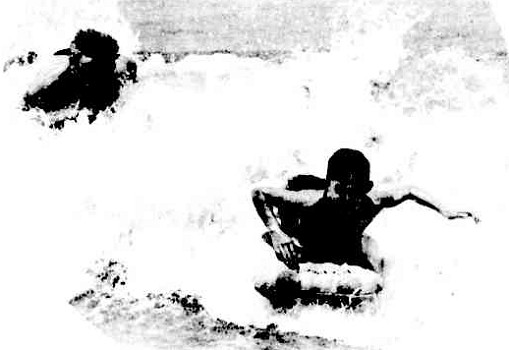
|
The edge of
your satisfaction is somewhat blunted at the next attempt,
when you inexplicably find yourself under the board instead of upon it.
By now you are feeling
the effects of your struggles.
Determined to finish
on a high note, you exert yourself to the utmost.
Exasperatingly, the
more you try the less successful you are.
Then, when about to
give up in despair, off you go again in a ride more
thrilling than the first.
The board bumps up and down
delightfully, and you make the grade in great style,
adroitly avoiding the bump near the edge by slithering
off at the psychological moment.
You go out apparently
unconcerned, actually tingling with well-being.
Your first lesson in surfing is over: you
are convinced that there is a technique to it.
You will probably
never master it entirely- it is an elusive business- but
of this you may be sure: you will never as long as you
have the energy and the opportunity, be able to resist trying to
become more and more expert.
Henceforth, in
fact, you will be enslaved to the surf; the
fascination of golf or fishing will be as nothing
to it.
Trove
1939 'SURFINGWITH OR WITHOUT TEARS', The Argus
(Melbourne, Vic. : 1848 - 1957), 14 January, p. 5.
(The Argus Week-end Magazine), viewed 14 Aug 2016,
http://nla.gov.au/nla.news-article12086332
The Daily Telegraph
Sydney, 16 January 1939, page 3.
PEOPLE ON PARADE
Jo Fallon and
his camera at Palm Beach got these happy,
after-the-heat-wave pictures
on the sands of the seashore
grown cool again.
...
BARTON HONEY, well-known figure on the beach.
He is considered one of the surf board experts of Palm
Beach.
Trove
1939 'PEOPLE ON PARADE', The Daily Telegraph (Sydney,
NSW : 1931 - 1954), 16 January, p. 3. (Home Magazine and
Film News), viewed 25 Mar 2019,
http://nla.gov.au/nla.news-article247447375
|
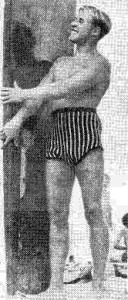
|
Daily Telegraph
Tuesday, 24 January 1939, page 16.
Team Of Surfers May Visit Hawaii
A team of
three or four of our Australian surf life savers may visit
Honululu in July.
The proposal
is being considered by the Surf Life Saving Association of
Australia.
Members of the
team would compete in the Inter-Pacific surf board
championships.
They would
also give displays of rescue work by surf boards.
A conditlon of
the tour is that the Hawaiian Association reciprocate with a
visit to Australia in 1940.
Annual Event
The proposal
was submitted by the Daily Telegraph.
If the
proposal Is adopted the Surf Life Saving Association will make
the surf board championship an annual fixture.
The first
championship would be held at the Australlan championship
carnival on March 18, at Manly.
Delegates at
yesterday's executive meeting of the Surf Associatlon were
enthusiastic about the scheme.
Forerunner Of Others
"The offer is
the greatest in our history," said the chairman (Mr. Adrlan
Curlewis).
"It gives us
the opportunity of publicising our work overseas.
"Successfully
managed it should be the forerunner of many overseas tours.
"I feel that
while taking part in the surf board championships our
represenatives should give demonstrations of surf rescue work.
Commitee Elected
"The question
is so important that I feel the best interests would be served
by appointing a special committee to conslder the offer and
report to the executive on Wednesday," added Mr. Curlewis.
A committee
comprising Messrs. Curlewis, R. J. Doyle, K, Hunter and C.
Mack was appointed.
Mr.
Hunter sald tests had shown Australian surfers the equal
to those in other parts of the world.
"The world
record for a still water swim with a surf board is 31 1/2
sec.," said Mr. Hunter.
"I know of
several who got within a few seconds of this time without
special training."
Proposed Events
Suggestions
for the Honolulu tournament are for a special trophy award on
apoint score basis over four events.
Events
proposed are surf board out-and-home paddle race, surf board
tandem race (, sic) surf board display, and surfboard rescue
race.
For the resue
event the services of a good distance swimmer to act as
patient would be needed.
Daily Telegraph
Monday, 30 January 1939, page 1.
Blind Surfer Saved, In Peril
From Rocks
A blind surfer was rescued by lifesavers at Freshwater
yesterday as he was about to be washed against rocks.
The man, who
had been surfing on a rubber float, is Eddie Collins, 28, of
Railway Parade, Belmore.
He was about
150 yards from the shore, when his plight was noticed.
N, Holliday
and W. Wilson, members of the Freshwater Surf Livesaving Club,
rescued him, '
Collins cut
his heel on a rock, but was otherwise unhurt.
Known On Beaches
Blind since
childhood, Collins is akeen surfer, and visits most of the
metropolitan beaches.
He is known to
the life savers, who keep special watch over him.
He takes his
rubber float out to the first line of breakers, and
finds his way about in the surf by the voices of others.
"We can't keep
him away from the surf, but we worry every time he goes in,"
his mother, Mrs. F Collins, said last night.
Collins walks
unerringly in the streets, sometimes rides a bicycle, and
plays a piano accordion.
He works at
the Blind Institute.
Page 5
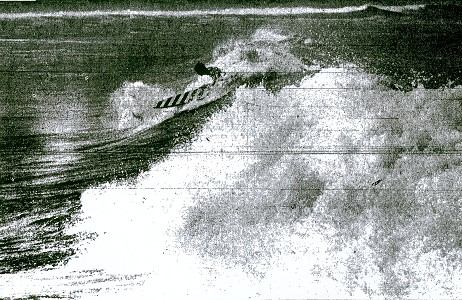 |
Poised
for the shoot.
This
surf-board rider, at Manly yesterday, has caught the
crest of a huge "breaker" at the right moment for a
perfect shoot. |
Weekly Times
Melbourne, 4 February
1939, page 6.
Losing his surf board while out beyond the breakers at
Lorne, Frederick William Grigg, 22, of Lome, was
drowned.
Trove
1939 'AUSTRALASIAN
NEWS in BRIEF', Weekly Times (Melbourne, Vic. : 1869 -
1954), 4 February, p. 6. (FIRST EDITION), viewed 25 Mar
2019,
http://nla.gov.au/nla.news-article225577139
Sunday
Times
Perth, 5 February 1939, page 3.
Surf Board Riding- In Stages
This youthful surf enthusiast has had a long wait
in the deep water for this "beacher."
But now he has caught it and adroitly stands up on
his board, anticipating the thrilling run down the wave,
but no .. he has lost his balance and the board goes on
without him.
Trove
1939 'Surf Board Riding
In Stages', Sunday Times (Perth, WA : 1902 - 1954),
5 February, p. 3. , viewed 14 Aug 2016,
http://nla.gov.au/nla.news-article59000119
Daily Telegraph
Tuesday, 7 February 1939, page 1.
Pacific Surf-Board Title
Challenge to Australia from Hawaii
Negotiations
have been launched for surf-board champions of Australia and
America to meet in an international contest at Hawaii in July.
The Daily
Telegraph has received a challenge from Honolulu for
Australians to match the skill of American surf board
champions.
Can
Australians beat Honolulu surf-board men in their own surf?
To decide
this, the Daily Telegraph is negotiating with the Surf Life
Saving Association to find suitable surf-board men to send to
Honolulu.
Immediately
the challenge was received the Daily Telegraph diecussed the
inter-natIonal surf-board match at Honolulu with the Surf LIfe
Saving Association executive,
The propoeal
was greeted enthusiastically.
A
sub-committee to suggest the means of finding the right
men to represent Australia at Honolulu was appointed at
yesterday's executive meeting of the Association.
Committee
members are: C, Whitehead, vlce-president and member of the
examination board; Mr. J Cameron, honorary chief
superintendent of examinations and instruction; Mr. K, Hunter,
executive member and honorary solicitorI for the association;
and a representative of the Dally Telegraph.
Americans Keen
This committee
will meet immediately.
Further
detalls or the proposal wilI be announced shortly.
A cable
message from Honolulu yesterday said sportsmen there were
following the proposal with typical American eaierness.
The famous
Hawaii Beachcomer Club of American and Hawaiian University
athletes is leading the movement for the international test.
Among the
prominent swimmers supporting it are Duke and Sam Kahanamoku
and Marlechen Wehselau, former American Olympics, who have
visited Australia.
Pacific Olympiad
The proposaI
may become more than a challenge match between Australian and
Honolulu surf-board men.
Overtures have
been made from Honolulu to San Francisco and Los Angels
athletic leaders.
It bas been
suggested that the contest might delelope into annual PacifIc
Olympic Games.
"Whether this
happens or not, the proposal for an Intenational surf-board in
Hawaii includes a return contest in Australia next year.
Plan Welcomed
The president
of the Life Saving Association Mr. Adrian Curlewis said
yesterday:-
"The proposal
is the most welcome one we have heard for a long time.
"We are
wholeheartely behind it.
"It will
provide a magnificient oppurtunity for us to demonstrate
the value of the surf-board in life saving.
"Also the high
skill of our Australian life savers whose presence on the
beaches makes surfing safe."
Daily Telegraph
Wednesday, 8 February 1939, page 1.
SURF-BOARD MEN DIFFER ABOUT TITLE CHANCES
International Test Planned At Hawaii
Can Australian
surf-board champions match Americans in the Hawaiian surf?
Two of
Australia's most expert surf-board riders differed on this
point yesterday.
They were
discussing the proposal for an international surf-board
contest between Australia nad America at Honolulu this year.
"Nobody in the
world could beat the Hawaiian beach boys in the surf," said
the fomer president of Palm Beach Surf Life-Saving Club.
Mr, Ralston is
one of the pioneer surf-board riders, who took up the sport in
1914, after Duke Kahanamoku, of Honolulu, introduced It to
Australia In 1911 (sic).
"The paddle
out to the waves, of any- thine up to a mile, would try our
men," he said.
"The beach
boys have been doing nothing else all their lives."
"But with
fast, hollow boards, and training, our men could compete with
anyone over there."
Arm-Chair Rides
"WaIkikI
waves are what we call 'arm-chair rides'," said Mr. C. J.
("Snow") McAlister, of Manly, triple surf-board champion of
Australia, yesterday.
"The broken
surf of Australia demand tremendous skill of the surf-board
rider.
"I think our
best men have enough skill to match anybody in the surf.
"If they
started with the same boards, I think our men would finish
in front.
"Some of the
Hawaiians I saw in our surf were not very impressive.
"Even Duke
Kahanamoku found our surf difficult ro begin with."
Club's Support
ln Hawaii,
the Beechcomber (sic) Club of American and Hawaiian
University athletes is leading the move for an
inter-national test.
A challenge
has been received from Honolulu for Australians to match the
skill of Amerlcan surf-board champions.
The Daily
Telegraph has dlscussed an international surf-board match at
Honolulu In July with the Surf Life Saving Executive.
A
sub-committee has been appointed to suggest means of finding
suitable men to represent Australia.
Daily Telegraph
Thursday, 9 February 1939. page 7.
Claims Australians Match For Anybody In Surf
View Of Former Champion
Harder
To
Ride Local Waves
The claim
that Australian could match anybody in the surf was made
yesterday.
Mr CIaude
West, ex-surfboard champion, who has beaten Honolulu
surfboard men in the Australian surf, expressed this view.
The type of
surf we have is the toughest in the world to master, and
Australians could hold their own in the easier Honolulu
surf," said Mr West.
A challenge
has been received from Honolulu for Australian surf-board
champions to match the skill of Americans.
The Daily
Telegraph has dicussed an international test at Honolulu
with the Surf Life Saving Associatlon executIve.
First Australian
A
sub-committee is working to suggest means of finding
suitable men to represent Australia.
Mr, West, an
ex-surf-board champion, yesterday discussed the view of Mr
J. M. Ralston, former president of Palm Beach Surf Life
Savlng Club, that Hawaiians were unbeatable in thelr own
surf.
"I was the
first Australian to take up surf-board rlding." he
said yesterday.
I Iearnt on
Duke Kahanamoku's board, which he left here after
introducing surf-board riding to Australia before the war.
Beat Kahanamoku
"I beat Sam
Kahanamoku, his brother of Honolulu, when he came here.
"I beat Ludy
Langer, another Honolulu man.
"I saw
Mariechen Wehselau, when she came here, and she was not as
good as some of our Australian women.
Other
Hawaiians I have seen in our surf have been behind our men.
Harder Surf
I am certain
our surf-board men can hold their own in any surf
where surf-boards are ridden.
"Men have
to be more skilled and tougher to ride our waves.
"They have
to battle out against terrific seas.
"They have
to ride a wave that dumps and breaks, manoeuvring their
boards bagainst strong undertows.
"Would Be Picnic"
"Thye
smooth, unbroken roller of Honolulu would be a picnic for
our men.
"The paddle
out to distances up to a mile there would be nothing in
their smooth swell.
"Why we
would often 65lb. boards from Manly to Freshwater and back
thinking nothing of it!
Duke and Sam
Kahanamoku and Mariechen Wehselau are amoung the prominent
Honolulu surfers who are supporting the move for a
surf-board match between America and Australia this year.
The Referee
Thursday, 9 February 1939.
Page 15
Australians Are "Tops" in Surfboard Riding.
Our Big Seas Rattle Clever Hawaiians.
Thrills and Spills On Every Wave.
Famous Coach Tells How To Ride A Surf Board
by Harry M. Hay
(Ex-Olympic
Representative and Australia's Foremost Swimming Coach)
What great
strides this sport has made in Australia!
A few years
ago it was hardly known in this country.
The
Hawaiians introduced us to this exhilarating, thrilling
pastime, and to these romantic tropical islanders is due our
warmest thanks.
But typical
of our race, the youth of Australia has developed the art
until to-day they are the equal In skill of their dusky
natatorial neighbours.
In fact, in
my opinion, we have seen exhibitions by our own lads in
Australia that have exceeded the skill of the most talented
Hawaiians.
The surf
conditions of the Hawaiian Islands differ considerably from
those in Australia.
The waves
of the famous Waikiki Beach at Honolulu do not break.
Assisted by
a reef some distance off shore, they come in the form of a
grand swell or roller.
It is
comparatively easy to catch a roller with the long narrow
surfboards and ride it right to the shallows, even high and
dry on the sands.
The steady,
even passage in allows the rider to perform apparently
difficult tricks with ease.
Our
conditions are different.
Our waves
are irregular, bank up to great heights, and break some
distance from the shore.
In order to
choose the correct type of wave and ride it expertly and
safely, one must summon far greater daring and skill than
the Waikiki rider has to do.
Several
types of boards have been used in Australia.
We started
with the small hand-board until to-day the accepted
surfboard is a huge specially shaped piece of picked timber
having distinctive marine advantages.
The
hand-board measures about 12 inches square and is light in
weight.
The
manipulation of this board is an easy matter.
As the
suitable wave breaks it isplaced in tront of the "shooter,"
a full man's Iength of the lett hand,
at the same
time stroking at the side of the body with the right.
When the
wave is property mounted, both hands grip the board. holding
it almost flat on the water.
The
"surfer" is carried shorewards by the wave, head free and
shoulders clear and feet free to assist when the wave is
losing its strength.
This method
is applicable to almost any size wave, and is comparatively
simple.
The
handling of the real surfboard is a much more difficult
matter.
It calls for
care in selection, water knowledge, choce of wave, and
expert manipulation.
The
accepted measuremnets for the regulation surf board are:
Length 9ft
6in; width at back end 20in; centre 22in, tapering down to
an oval shaped nose of 10 to 12 inches.
Thicknesses
vary from 1 3/4in at back, graduating to 3in at the centre,
and narrowing to 1in or less at the point.
Redwood is
the most suitable timber for surfboards, but if
unprocurable, cedar ls recommended.
Surfboard
riding has become an attractive feature at surf carnivals,
and the displays and stunts which youthful Australians
perform on these huge boards astound onlookers - even the
Hawiians themselves.
This
assertion was verified during the 1915 visit to Australia of
famous Hawaiian swimmer and surfboard expert, Duke
Kahanamoku.
He enjoyed
our surf, but despite his great knowledge of surfboard
riding, he admitted that the young Australians excelled his
own efforts under the unusual local conditions, of which, of
course, he had little experience.
Ofrecent
years attempts have beenn made to conquer tbe waves by the
introduction or the surf canoe, surf ski, and latterly the
surfoplane.
The
manipulation or these new devices call for skil and a
certain amount of daring, but fail to meet the heights of
individual accomplishment which a surfboard rider must
attain in Australia.
To begin
surfboard riding the novice is advised to make astudy of the
Australian surf, paying particular attention to the waves
themselves.
Two
particular types which roll in on our beaches will interest
the "surf-shooter" and the surfboard rider.
They are
commonly known as the "roller," or "slide," and the
"dumper."
The rolling
or "roller" wave is encountered mostly at high-tide.
The "dumper"
is more frequent al low tide, but do not take this as a hard
and fast rule.
The
"roller,", or slide, is the wave to be ridden; the "dumper"
is the wave to be avoided.
It is
dangerous and the cause of many accidents, but can be picked
up quite safely by one who has become expert in the art of
"broaching".
Broaching
means turning the surfboard sideways and parallel to the
wave.
At the same
time you
ion in line
with the hipS
iwhen tbe
,rros are thoroughly re axed and
~'Cked out
of the water, hending e arms at the elbows and carry-
ng the bands
underneatb (en- sUres proper relaxation>, and for-
..."ard ti> the straight out position
.0 front and
at the sides of .the- ~ard. .'
IS is the
propelling move- ment, and when cOluinued ought-to drive the
board and-
rider alol1g
at. a fairly fast. rate. ""h.e[1 the ri~er becomes expert
he may now
paddle his board t to the wbfoekea wav&;, but- is vised
to pick a i day when the ves.re not too big.
-He next
picks out the wave ~n hieh he intends to try hie akill, d
then ~8Jt~ tbe board so
~ ll.cin 1.8
h 0 reward s~.H ~
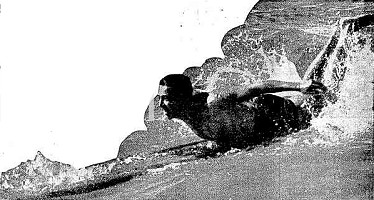
L.
A. MORATH, of the Manly Surf Life-Saving
Club,
demonstrates the ideal balance for
surf-board
riding.
(Top): Picking up the wave.
|
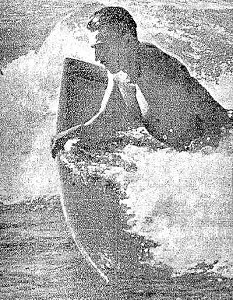
Broaching the slide.
|
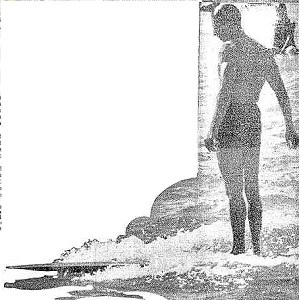
The perfect standing balance.
|
Trove
1939 'Australians Are "Tods" In Surf Board Riding ', Referee
(Sydney, NSW : 1886 - 1939), 9 February, p. 15. , viewed 14
Aug 2016, http://nla.gov.au/nla.news-article127603238
The Catholic
Press
Sydney, 9 February 1939, page 29.
Australian Surf Board Aces Would Test
World's Best.
The news that a team of Australian lifesavers may visit
Honolulu to compete against champion surfboard riders from
America at an inter-Pacific championship has caused
widespread interest in surf clubs
along the coast.
A special subcommittee has
been formed by the Association, and is investigating the
matter.
The selection of a team
would cause some difficulty.
At all the beaches there are probably dozens of splendid surf board exponents.
Some are 'trick' riders,
and others are at their best in the heavy surf.
However, it is generally
found that there is an outstanding performer at every beach,
such as George Connor is at Bondi.
Undoubtedly, a team of
Australian surf board riders would more
than favourably compare with the American exponents.
Trove
1939 'The REALM of SPORT', The Catholic Press (Sydney, NSW :
1895 - 1942), 9 February, p. 29. , viewed 14 Aug 2016,
http://nla.gov.au/nla.news-article104367392
Daily Telegraph
Friday, 10 February 1939.
Page 7
Honolulu Surfing Skill Matched Here
Expert's Test
Stop Watch Times Taken
Tests against
a stop-watch at Pittwater proved Australians could match
Americans in the Honolulu surf.
Mr. Blue
Russell, surf-board expert of Palm Beach Life Saving Club, who
made the tests, said this yesterday.
He was
discussing the proposed international surf-board match between
Australia and America at Honolulu.
Surf-board
experts have differed on whether Australians could paddle
their boards over a long distance.
More Difficult Here
Paddling
record times in the still water of a Honolulu canal, over a
distance from 100 yards to a mile, are held by Tom Blake, an
American." said Mr. Russell yesterday.
"My tests,
over the same distances and in the harder water of
Pittwater, showed just about the same time." he said.
Mr. Russell
was timed at Pittwater by Dr. T. H. Guthrie, of Whale
Beach,.
"We contend
that Australians, their stamina toughened by our terrific
seas, could match Honolulu men at paddling a board."
he said.
"And their
waves would be easy for us as laying on a bed."
3-Ply Board Used
In the
Pittwater tests, a light hollow board of special three ply,
about 15 feet 4ins. long was used.
The board
was built by Mr. Russell , who considers it as fast as
boards used at Honolulu.
It weighs
about 30lb., whereas a solid board would weigh about 60lb
(?, unclear transcription)." he said.
A challenge
has been received from Honolulu for Australians to match the
skill of American surfboard champions.
The Daily
Telegraph has discussed an international test at Honolulu
with the Surf Life Saving Association executive.
Daily Telegraph
Saturday, 11 February 1939.
Page 20
Need Years To Learn Surf Riding
By C. J.
("Snowy") McAlister, Surf Board Champion of Australia.
Surf board
riding is an art that can never be perfected.
We in
Australia learnt the rudiments after seeing the Hawaiian,
Duke Kahanamoku, before the war.
Now, I think
we could teach our teachers.
No other
Hawaiian has ever managed to duplicate the Duke's amazing
skil.
Such noted
swimmers as Sam Kahanamoku, Ludy Langer, Pua Kealoah, and
Bill Harris came here with big reputations.
They were
adepts in their own surf but were "all at sea" when tying to
shoot the huge dumping breakers on Sydney beaches.
Keen Judgment
Handling a
board on Sydney beaches
requires
split-second timing and judgment; whereas Hawaiians had been
used to waves in Honolulu which side slowly.
Australians,
with constant practicein rough and dangerous surf, have
become proficient to a remarkable degree.
Even the
largest "dumpers" can be held if the rider "broaches" his
board down the face of the steep wave.
"Broaching"
a board means to turn the board underneath the rider and
parallel to the breaker, pressing heavily on the edge
nearest the wave.
When the
main force of the wave is spent, the board is swung back
under the body into normal position.
Standing on
the head while shooting to the beach is easily the most
spectacular feat.
It requires
great skill and concentration.
Thrilling Action
But perhaps
the most thrilling to the rider, although not so interesting
to the specator, is "funneling", or riding the "corner" of a
sliding wave.
This means
manoeuvring the board to keep on the breaking corner of the
wave, and shooting right across the face of the wave.
Twice the
speed is obtained because if the run into the beach is 300
yards, there is the possibility of gaining another 300 yards
across the beach with the wave.
It takes a
beginner a full season to learn to handle his board in our
surf.
The
following season he can start to learn tricks.
But he never
finishes learning.
Difficult Feats
Some of the
hardest feats on a board, necessating years of practice,
are:-
ChangIng
board by stepping from one to another, when two riders are
on the same wave.
Standing up
backwards on the board while shooting shorewards.
Standing
upright with a light passenger astride your shoulders.
Riding a
wave tandem, both standing.
The
direction of the board coming down a wave can be varied by
using the foot as a tiller or by cupping the water with the
hands.
Normally, a
well constructed and well-handled board will keep its
correct course.
Since the
proposal to send an Australian team of surf-board riders to
Honolulu was first mooted, several of Australia's greatest
swimmers have asked me to teach them to use the board.
Tommy
Adrian, former Australian swimming coach of "Boy" Charlton,
always believed in the use of surf boards in conjunction
with baths training for swimming.
So,
apparently, did Duke Kahanamoku who was at one time world's
champion sprint swimmer.
Daily Telegraph
Wednesday, 22 February 1939.
Page 1
International Surf Contests At Honolulu
Aust. Life savers Challenge U.S.A.
A surfing
match between Australia and America will be held at Honolulu
in July.
One of the
most spectacular advertisements for Australia ever sent away,
a team of surf life-savers will go to Honolulu to meet
American and Hawaiian surf-men.
They will
compete against each other in the water, o surf-boards, in
Australian surf-boats, in Hawaiian canoes, and the Australians
will demonstrate the surf rescue system evolved here.
Arrangements
completed last night a a meeting of the delegate council of
the Surf Life Saving Association of Australia make this
possible.
Hawaii is also
arranging to send a return American team to Sydney for a
second Pacific Surf Games early next year.
Daily Telegraph Idea
The whole
scheme has developed from a Daily Telegraph plan for a team
of surf-board men to accept a Honolulu challenge to match
Hawaiians in their surf.
A
sub-committee to organise a team of at least 10 men, and to
raise funds towards sending it away was appointed at the
meeting of the delegate council of the Surf Life saving
Association last night.
Further
backing is being found by the Australian National Travel
Association and The Daily Telegraph.
Surf Club
Leaders Hail Proposal - Page 2, Cols. 4& 5.
The Referee
Thursday, 23 February 1939.
Page 16
Tommy Walker Says-
"I Brought First Surfboard To Australia"
| In a
letter to Harry M. Hay, Australia's foremost swimmimg
and surf coach.- Tommy Walker, one-time surfboard
champion at Manly (N.S.W.), writes:
"I
saw an article by you in 'The Referee' re
surfboards, so enclose a photo of myself and
surfboard taken in 1909 at Manly.
This
board I bought at Waikiki Beach, Hawaii, for two
dollars, when I called there aboard the 'Poltolock.'
I
won my first surfboard shooting competition at
Freshwater carnival back in 1911, and that wasn't
yesterday.
Regards."
Walker
was a well known figure at Manly at the time he
writes about.
He
figured in a couple of unusual, if not remarkable,
incidents.
* * *
Time
came when Tommy decided to catch a shark for the
purpose of exhibiting it to the public at three-pence
a head.
He
brought three other lads into the enterprise and
between them they raised the necessary capital to
buy a hook and line and to hire a tent in which to
install the monster of the depth.
|
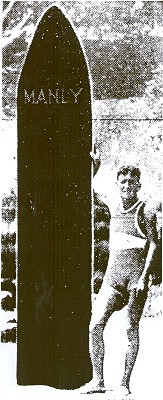 |
But first
they had lo catch their fish.
They
selected Fairy Bower beach as their base and set a watch on
the hill overlooking it.
But first
they had lo catch their fish.
They
selected Fairy Bower beach as their base and set a watch on
the hill overlooking it.
On the
second day of their vigil, the required shark was sighted.
Like a
policeman on his beat, he came leisurely from the direction
of South Steyne.
And he was a
whopper, a tiger, 14ft 2in in length, as was proved later.
He was duly
landed struggling on to the beach and a curious public had
paid £12/10/- to view him when the Council's inspector of
nuisances intervened to the manifest relief of the residents
in the vicinity.
But one may
ask, "Where does the hero stuff come in?"
Well, it was
this way.
When the
shark was sited, the watchers on the hill signalled to Tommy
(who was waiting on the beach) and he immediately set out in
a small dinghy to drop the bait at the spot it was
anticipated the shark would cross.
The craft
capsized.
So Tommy
swam with the bait, a 7lb salmon, and lilerally spilt it
into Ihe shark's mouth.
The shark
grabbed it - and the rest was easy.
Someone
said, "I wouldn't have done that for £10,000."
Tommy
replied simply, "There was no danger - when salmon are
about, a shark has no time for anything else,"
* * *
In the other
incident Ivay (sic, Ivy) Schilling was Ihe heroine.
She will be
recalled as J. C. Williamson's principal dancer.
The company
was having a successful season at the Thealre Royal.
A strong
swimmer, she was surfing at South Steyne one morning, when
only two others were in the water.
Walker was one
of them.
Miss
Schilling had crossed a deep channel and was resting on a
sandbank, and was watching Walker shooting.
He could
swim like a fish.
This was at
it time when large surfboards were unknown in Australian
waters.
However,
Walker did not need any adventitious (sic) aids when
shooting, at which he was one of the recognised adepts.
II was
impracticable, however, to shoot right into the sand because
of the channel, which banked the surf up.
Afler his
third shoot, Walker appeared to be in sore trouble in the
channel.
His scream
for help galvanised the dancing star into action.
With
powerful strokes, swimming trudgeon style, she quickly
covered the necessary 30 yards to reach the youth who
was sinking for the third time.
He appeared
to be in a fit and struggled violently as the gallant lady
swam with him to the shore.
* * *
Just at
this moment the professional lifesaver, the late 'Appy Eyre,
arrived, and he worked on the unconscious form of Walker,
who, when he came to his senses, ejaculated, "Well this is
the last time I'll go surfing immediately after a heavy
breakfast."
The evening
papers rang with the story, and the performance at the Royal
was held up that night when Miss Schilling appeared on the
stage.
Members of
the audience from all parts of the theatre rose and cheered,
and cheered, and cheered again.
And Tommy -
what of him?
Just about
that time, a week beforehand, in fact, Claude Eric Ferguson
McKay had been appointed to the position as Williamson's
publicity man.
Walker, if
unwittingly, had brought one of Williamson's stars into the
limelight - had given her the opportunity of appearing as a
heroine in a drama off the stage.
McKay was
delighted.
He presented
Walker with a brand new £5 note.
Notes:
The article by
Hay appeared two weeks earlier in The Referee, 9
February 1939, page 15, above.
The claim to be
the first surfboard in Australia can only be attributed to the
paper's sub-editor, and not Tommy Walker.
This may, or may
not, be the Hawaiian surfboard often claimed to be imported by
Manly identity, C. D. Paterson, sometime between 1908 to 1912.
The boardriding
performance of a Mr. Walker at the second Freshwater
Life Saving Carnival was reported by The Daily
Telegraph, 27 January 1912, page 21.
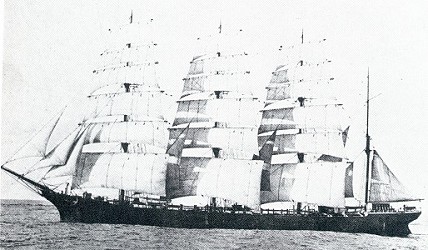
Poltalloch off the Colombia River, circa 1913.
Poltalloch aground at Willapa
Bay, circa 1900.
|
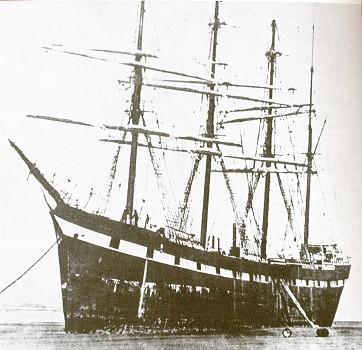 |
The
Australian Women's Weekly
25 February 1939, page 31.
HONOLULU'S
BEACH GIRLS
Beach
Umbrellas Swimming &
Surfing Instruction
AUSTRALIAN surf men are going to Honolulu to compete
against crack Hawaiian surf-board stars.
Suppose, instead of our men, Hawaii had challenged
our surf girls?
How would they compare with Honolulu's famous
bathing beauties?
The Australian Women's Weekly asked its Honolulu
representative, John Williams, to answer the
question.
"Well," he said, "Honolulu has one advantage.
It is a holiday resort for the beauties of Hollywood
and American society.
|
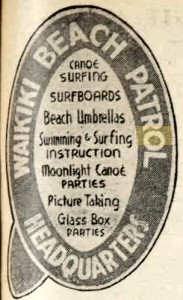
|
But, as I remember Sydney
beaches - I think you would win."

SURF-BOARD RIDING
was invented in Hawaii.
Duke Kahanamoku, Hawaiian swimmer, introduced it
here. |
WAIKIKI
BEACH is famous.
So is its Royal Hawaiian Hotel.
"Along the shaded promenade," says John Williams,
"you can see at almost any hour of the day
some of
the loveliest women of America."
TYPICAL Waikiki girl is Alice
Aldrite.
In California,
an occasional Hawaiian trip
is the social thing to do.
[Not shown]
ROCHELLE HUDSON, like other Hollywood film
stars, trim in her swim-suit, decorates
Waikiki promenade.
"But."
says John Williams, "many of their swim-suits
were never meant for swimming."
|
Trove
1939
'HONOLULU'S BEACH GIRLS...', The Australian Women's Weekly
(1933 - 1982), 25 February, p. 31. , viewed 23 Aug 2016, http://nla.gov.au/nla.news-article51591967
Newcastle
Morning Herald and Miners' Advocate
3 April 1939, page 12.
SURFBOARD TRIALS
Elimination trials for
candidates for selection in
the surfboard section of the
surf team to go to Honolulu during July were held at North Narrabeen today.
Speed trials were held in
Narrabeen Lake this
morning. and in the surf this afternoon.
There were 35 competitors
and 10 were selected for further tests.
Among them was Alan
Fidler, of Newcastle, who
has also been selected for
further tests in the surf swimming section.
The 10 selected to-day
were-
A. Fidler (Newcastle), F.
Boorman (North Bondi), R.
Chapple (North Bondi), J. Cohen (North Bondi), J. May (North Bondi), L. Morath
(Manly), R. Russell (Palm
Beach), F. Stroud (North Bondi), H. Wicks (Manly), G. Connor
(Bondi).
Trove
1939 'SURFBOARD TRIALS', Newcastle Morning Herald and
Miners' Advocate (NSW : 1876 - 1954) , 3 April, p. 12.
, viewed 22 Aug 2016, http://nla.gov.au/nla.news-article134187367
The
Courier-Mail
Brisbane, 5 April 1939, page 10.
PADDLING to Honolulu.
Some of the 33 competitors
just after the start of the 880 yards surf-board
race on the Narrabeen Lakes, Sydney.
The race
was a guide for the selectors of the
Australian team for the Pacific Surf
Games at Honolulu in July.
Trove
1939 'SOAP BOX DERBY : WORLD TOPICS', The
Courier-Mail (Brisbane, Qld. : 1933 - 1954),
5 April, p. 10. , viewed 23 Aug 2016,
http://nla.gov.au/nla.news-article39019495
|
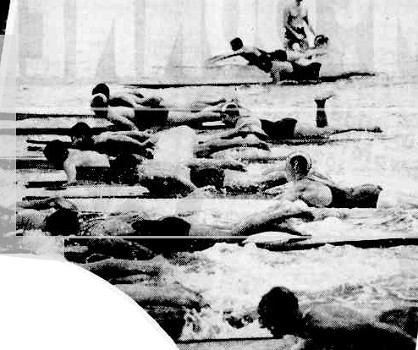
|
The Sydney
Morning Herald
Thursday 13 April 1939, page 20.
Heard Here
and There
By Mayfair.
QUITE the quaintest Palm Beach sight is that of Knightley
("Blue") Russell speeding through the waves on his special
surf-board, complete with a
battered green felt hat clinging to his red hair.
'Blue' is a severe sunburn subject,
and the hat is therefore an essential part of the programme.
After watching "Blue" at practice the
other morning, a friend of mine remarked that surely he
would get house-maid's knee kneeling oh the board for so long at a time.
I am almost ashamed to admit that
some-body else suggested he was probably "board" stiff!
The Telegraph
Brisbane, 1 May 1939, page
11.
Winner of
Surf
Board
Race
R. J. Noohan paddling his way
to win the surf board
test
held on the Tweed River to enable the judges
to
select representatives for the Australian tea
of
lifesavers for Honolulu.
Trove
1939 'Winner of Surf Board Race', The
Telegraph (Brisbane, Qld. : 1872 - 1947), 1 May,
p. 11. (SECOND EDITION), viewed 23 Aug 2016,
http://nla.gov.au/nla.news-article185110952
|
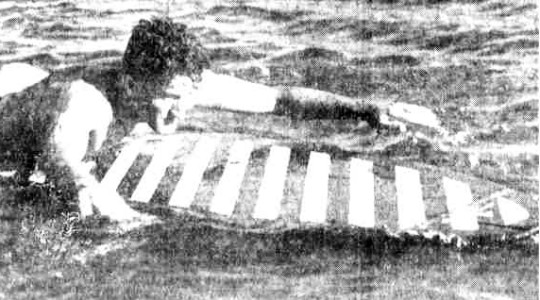
|
The
Catholic Press
Sydney, 11 May 1939, page 16.
Noel Ryan Showed
the South Africans How.
Having, amongst other achievements, won every
race in which he competed and made records over
all distances from 220 yards to one mile, Noel
Ryan, ex-Australian champion swimmer accompanied
by Eon Masters (diver) and Bob Willshire
(sprinter), returned from South Africa this week.
True, the standard of
swimming in South Africa is not nearly up to that in
Australia, but it is pleasing to see such a grand and
courageous swimmer as Noel Ryan, who has done so much
for the sport in this country, virtually finishing his
natatorial career on such a successful note,
Ryan was also able to give a demonstration of surf board riding at
Durban.
He is an accomplished
surfman.
Masters had to be
content with giving diving exhibitions during the tour,
as there was no opposition for him.
The lengthy Willshire had no trouble in winning the 150
yards South African title.
The report that
patrols are paid to protect the surfing public will
come as interesting news to the thousands of lifesavers
who voluntarily guard the beaches along our Australian
coast.
1939 'The REALM of SPORT', The
Catholic Press (Sydney, NSW : 1895 - 1942), 11 May,
p. 16. , viewed 23 Aug 2016,
http://nla.gov.au/nla.news-article106367729
Newcastle Morning
Herald and Miners' Advocate
16 May 1939, page 8.
HECTOR SCOTT GETS
PLACE IN SURF TOURING
TEAM
THERE WILL be no surprise in Newcastle surfing circles that
Hector Scott has gained
a place in the Australian team to go to Holonolulu to compete in the Pacific Games.
He has outstanding ability, and his claims to a place were very strong.
Scott comes from a
well-known Newcastle
surfing family, and, indeed, a family well known in the district, where he has always lived and where he was educated.
His brothers, George
and Victor,
are as well known as he, and, like Hector, have many Northern district championship titles to their credit.
George Scott was the council's life-saver on Stockton beach last summer.
Hector Scott's
successes when a member
of the Australian team of eight which toured New Zealand on an educational tour in 1937 suggested that he would be difficult to omit from the team to go to Honolulu, and his work in the heats which preceded the selection added materially to his already good prospects.
He was captain of
Newcastle Surf Club
in 1937 and was the
club's sort champion in the same season.
A year before he was the club's instructor-in-chief.
He has been a member
of the Newcastle Club
for more than 15 years and was Northern district junior surf champion- and an unbeaten one- for some seasons.
At the Australian
carnival in the season
of 1927-28 only Noel Ryan and Arthur Besomo, two outstanding surf swimmers, defeated him in a very select field which contested the surf championship
He has represented the
district in Australian
surf championships every season since then.
In the same season he finished second in a teams race, and was a member of the district's R. and R. team which finished third.
Scott has had many successes in still water and surf, but probably his greatest success was duiriig the carnival held on Newcastle Beach during the Duke of Gloucester's visit in 1934.
On that day he won the surf-board
race, was the patient in
the R. and R. competition and was first to the buoys, and finished the day by winning the open-surf race.
He has won the open surf race at the club's carnival on several occasions, and won the surf
board race on three occasions.
He is a member of the
Board of Examiners of the Newcastle branch of the association and is regarded as outstanding in his knowledge of drill and methods.
Scott will be a
valuable man on the
tour, for he can take part in any of competitive surfing's
many requirements.
In addition to his
great ability in an R.
iand R. squad, Scott, as his record shows would be difficult to defeat in open swimming event, and can be expected to do well in board races and, if necessary, can help in the boat crew.
And, besides all these
talents, he is a
first-class instructor.
His selection will be
deservedly popular.
(The team published on Page 9.)
The Courier-Mail
Brisbane, 17 May 1939, page 16.
HITCH OVER SURF
TOUR
SPORTING BODIES AT VARIANCE
Team Must Affiliate With Swimming Union
SYDNEY, Tuesday. The executive committee ot the Australian
Amateur Swimming Association decided to-night that the surf team
to visit Honolulu must affiliate with the Amateur Swimming Union
of Australia before its participation in still-water events in
Hawaii would be sanctioned.
The meeting also decided that the swimming union should appoint
the team's manager and that the finance also should be
controlled by the union.
Mr. James Taylor, president of the union, was at the meeting,
and when discussion of the proposed tour began it was apparent
that there were strained relations between the two bodies.
Mr. Taylor took exception to the terms of certain correspondence
on the subject.
After explanations and the production of files the atmosphere
cleared considerably, but members of the executive committee
adhered to their claim that the swimming union had weakened its
position by granting sanction to an unaffiliated body to send
away a team - composed partly of swimmers affiliated with the
Swimming Association and partly of men not so affiliated - and
sponsored in a way which they claimed constituted commercialism.
They also protested strongly against being given very little
information about the receipt of the official invitation from
the American Athletic Union to the team, which, they said, had
been received only during the last few days, although
arrangements for sending the team had been in progress for three
months.
Mr. A. Rennix said that they had been informed that an
invitation had been received by the Surf Life Saving Association
to send affiliated amateur swimmers.
Mr. J. Sheedy, honorary secretary of the Australian Swimming
Union, had informed the Surf Association that a conditional
permission had been granted, but subsequently has been
withdrawn.
It was now announced that a team was going to Hawaii, where 75
percent. of the swimming events would be in still water.
Mr. Taylor had said that no outside oganisation could take a
team away without the authority of the Swimming Union, but the
union would be giving away its control if it permitted any
movement to take away a group of affiliated swimmers.
The affiliation of the Surf Life Saving Association with the
Swimming Union also was essential.
The Swimming Association had not been asked to give its views on
the sending of the team, said Mr. Rennix, and it seemed that, if
this team had the authority of the Swimming Union, the
association should call for an Australian conference to consider
it.
Mr. S. B. Grange said that if, Robin Biddulph did not go, the
surf tour was off.
Arrangements already were in existence for holding the
Pan-Pacific games in New Zealand in 1940, but there was a
proposal now in evidence to have an opposition fixture in
Australia.
In reply to questions, Mr. Taylor said that the secretary of the
Amateur Athletic Union in America had cabled that their Honolulu
branch had approved of the invitation, which was official.
It was decided to invite the president (Mr. Adrian Curlewis} and
the hon. secretary (Mr. George Millar) of the Surf Life-Saving
Association to meet Mr. Taylor and the hon. secretary of the
Swimming Association (Mr. E. H. Sandell) to-morrow, with a view
to effecting an affiliation, to which, it was stated by Mr.
Taylor, the Surf Association was willing to agree.
THE TEAMS
As announced in The Courier-Mail yesterday,
only one Queenslander, A. Imrie, has been chosen in the team,
which is:
SURF BOAT CREW.
F. C. Davis (Manly) sweep, J. B. Harness (Mona Vale) stroke. R.
A. Dickson (Mona Vale) No. 3, W. A. R. Mackney (Mona Vale) No.
2, F. M. Braund (Palm Beach) bow.
RESCUE AND RESUSCITATION AND SURF SWIMMING.
J. L. D. McKay (North Cronulla), H. Doerner (Bondi), W. Furey
(North Steyne), A. Fitzgerald (North Wollongong), H. Scott
(Newcastle), A. Imrie (Burleigh Heads-Mowbray Park, Qld.).
SURF-BOARD RIDERS.
R. K. Russell (Palm Beach), L. Morath (Manly), R. Chapple (North
Bondi).
Trove
1939 'HITCH OVER SURF TOUR', The
Courier-Mail (Brisbane, Qld. : 1933 - 1954), 17 May, p. 16. ,
viewed 22 Aug 2016,
http://nla.gov.au/nla.news-article40843003
Referee
Sydney, 18 May 1939, page 1.
Risk To
Biddulph's Olympic Chance
Hawaiian Surf Tour Edict From Amateur
Association
THE N.S.W. AMATEUR SWIMMING ASSOCIATION HAS
DELIVERED AN ULTIMATUM TO THE SURF LIFE
SAVING ASSOCIATION WHICH CAN NOT BE
DISREGARDED IF THE HAWAIIAN SURF TOUR IS TO BE A SUCCESS.
THIS is the outcome of an official invitation from the Amateur
Athletic Union of America to the Australian Swimming Union.
The A.A.U. asked the A.S.U. to sanction the Hawaiian surf tour
organised by the S.L.S.A., and that permission be given Robin
Biddulph to accompany the team;
The A.S.A. has placed three requirenients on the. S.L.S.A.
before endorsement of the tour will be granted.
They form the basis of an article which, appeared in 'The
Referee' on March 9.
These are the points with which the S.L.S.A. must comply:
'The manager shall be appointed by the Australian Amateur
Swimming Union.'
'The expenses of all affiliated swimmers must be handled by the
manager, in accordance with the rules of the International
Federation De Natation Amateur.'
'The Surf Life-Saving Association must apply for affiliation to
the Amateur Swimming Union through the various State
Associations before, the team leaves Australia.
'As far as the A.S.A. is concerned, afllliation means that the
S.L.S.A. shall pay the sum of £2/2/- as an annual
affiliation fee and register each of its amateur members with
this association.
They must sign an amateur declaration in accordance with our
rules.
Would Ban Trip
The capitation fee will be payable on such
members.
'These members are only registered amateur surf men entitled to
compete in restricted surf races.
Should they desire to compete in still water it will be
necessary that they, join afliliated amateur swimming clubs.
'Provided these three points are accepted uneciuivocally in ten
days, the A.S.U. will see that the tour is placed on a proper
international basis.
'The team will go with the full support of the Australian
swimming movement.'
A prominent swimming official said yesterday that if the
S.L.S.A. did not agree to the three points, the A.S.U. would ban
the trip.
American and Hawaiian authorities would be notified that members
of the team did not carry credentials.'
That would categorically quash the tour.
Hawaiian and American associations could not fail to observe an
Australian ultimatum.
It is to be hoped that the S.L.S.A. shows a clearer appreciation
of the position than formerly.
Unwittingly, no doubt,, the S.L.S.A. has placed the futures of
prominent amateur swimmers in jeopardy.
Robin Biddulph, Australia's best free-style swimmer, who is the
foremost member of the team, could be precluded from 1940
Olympic Games selection.
Robin Biddulph.
The tour must be sanctioned by the A.S.U., because it is the
only Australian body with international status.
Without its permission amateur swimmers in the team, and all who
compete against them, will be liable to suspension by the inter
national authorities.
The Hawaiian surf tour is a laudable project.
It could be the forerunner of many inter-Paciflc sporting
carnivals.
It would be a pity if an obstacle so easy to surmount brought
about its ruin.
The S.L.S.A., a highly efficient organisation in its own sphere,
will surely take this opportunity to expand its influence.
The team booked to sail for Honolulu on June 23, is:
F. N. Braund (Palm Beach).
C. R. Chappie (N. Bondi).
F. C. Davis (Manly).
R. A. Dickson (Mona Vale).
A. E. Fitzgerald (N. Wollongong).
H. Doerner (Bondi).
W. A. Furey (N. Steyne).
J. B. Harkness (Mona Vale).
A. Imrie (Burleigh Heads, Qld.).
J. L. McKay (N. Cronulla).
W. A. R. Mackney (Mona Vale).
L. Morath (Manly).
R. K. Russell (Palm Beach).
H. Scott (Newcastle).
J. R. Cameron (captain instructor).
R. Biddulph (Manly) will accompany the team as a swimmer.
He will compete against Hawaiian champions Nakama and Hirouse.
The tour itinerary shows that its financial success depends on
still water contests.
These are the only events for which admission will be charged.
Those who imagined the tour would be confined to surfing events
will be surprised that swimming plays the major part in the
programme.
(ITINERARY ON PAGE 24, COLUMN 7).
Trove
1939 'Risk To Biddulph's Olympic
Chance', Referee (Sydney, NSW : 1886 - 1939), 18 May, p. 1. ,
viewed 22 Aug 2016,
http://nla.gov.au/nla.news-article127608653
Referee
Sydney, 18 May 1939, page 24.
Hawaiian Surf
Itinerary July 24, 1939
FEATURING AUSTRALIA'S SWIMMERS AND LIFE
SAVERS AGAINST HAWAII'S BEST IN HONOLULU.
July 5 (Wednesday) : Australian team arrives in Honolulu.
Parade through town, finishing at the Governor's office.
Australian team presented to Governor.
Thence to Pali, to Wainianalo, around Koko Head, and back to
Army and Navy Y., team's headquarters.
July 6 (Thursday) : K.G.M.B. broad cast in evening.
July 7 (Friday): Australian team guests at luncheon,
July 8 (Saturday):. Australian team visits pineapple cannery and
sugar mill.
July 9 (Sunday) : Australian team will give life-saving
exhibition at Koko Head beach at 3 p.m.
Public admitted free.
July 10 (Monday): Parade through town by Australian team with
life boats and life-saving apparatus.
Local teams will also co-operate,
July 11 (Tuesday): Australian team will be guests of Al
Karasick'a wrestling show at Civic Auditorium.
July 12 (Wednesday): First night swimming meet at Natatorium,
Waikiki, featuring Australia's champion swimmer, Biddulph,
against Hawaii's best, Nakama and Hirouse.
Diving.
60yds freestyle, boys under 13 years.
50yds freestyle, girls under 18 years,
100yds freestyle, men, novice.
880yds freestyle,men, open.
100yds freestyle, women, open.
50yds backstroke, boys, under 13 years.
50yds backstroke, girls, under 13 years.
150yds backstroke, men, open.
330yds medley relay, men, novice.
100yds freestyle, men, open.
440yds relay, women, novice.
440yds relay, men, novice.
100yds surfboard race, men, open.
330yds medley relay, men, open.
July 13 (Thursday) : Free morning for Australian team; K.G.M.B.
broadcast In evening.
July 14 (Friday): Second night swimming meet, Natatorium,
Waikiki.
Diving tower, men, open.
50yds breastroke, boys, under 13 years.
50yds breaststroke, girls, under 13 years.
100yds freestyle, women, novice.
220yds. freestyle, men, open.
100yds breaststroke, women, open.
220yds breaststroke, men, open.
330yds medley relay, women, novice.
220yds breaststroke, men, open.
100yds backstroke, men, novice.
440yds freestyle, men, open.
100yds breaststroke, men, novice.
440yds relay, women, open.
440yds relay, men, open.
July 15 (Saturday) : Free to Australian team.
July 16 (Sunday): Life-boat, canoe, surf-board, ski, and
outboard motor regatta at Alma Moana Canal, in front of Alma
Moana Park, 8.30 a.m.
Programme of events as follows:
Outboard speed-boat race.
Canoe, six paddle. Junior men, 1 mile.
Inter-island life-boat race, 1 mile (sailor only).
Hawaiian, surf-board race, 1 mile (board must be 12ft, at least
601b, 12in width at stern).
Junior six-oar sliding seat barge race, 1 mile.
Canoe six-paddle senior race, 1 mile.
Freshman. six-oar sliding seat-barge race, 1 mile.
Australian ski paddling race, 1 mile, Hawaii v Australia.
Surf-board relay, women (8 to team) 1 mile, straight course.
Senior six-oar sliding seat barge race, 1 mile.
Australian life-boat race, Hawaii v Australia.
Canoe six-paddle, boys, under 16 years, 1 mile.
Surf-board relay race (8 men to team), 1 mile, straight course.
Finish of Pearl Harbor Yacht Club star boats, boat races In
front of Alma Moana Yacht Club.
July 17 (Monday) : Free to Australian team.
July 18 (Tuesday) : Australian team guests of Al Carasick's
wrestling show at Civic Auditorium.
July 19 (Wednesday) : Swimming meet at Panahou Tank.
150yds backstroke, men, open.
220yds freestyle, men, open.
Diving, 3-metre, men, open.
300yds medley, Individual, men, open.
100yds freestyle, men, open.
220yds breaststroke, men, open.
400yds relay, men, novice.
400yds relay, men, open.
400yds relay, women, open.
500yds freestyle, men, open.
300yds medley relay, men, open.
July 20 (Thursday): Morning free to Australian team.
July 21 (Friday): Australian team visit to Pearl Harbor and
Schofleld.
July 22 (Saturday) : Life-saving exhibition and sport programme
in front of Alma Moana Hotel, 3 p.m.
Public admitted free.
Life-saving rescue race, Australia v Hawaii.
Australian life-boat race, through surf.
100yds foot race on sand beach.
Surf-board race, through surf.
400yds relay race on sand beach.
July 28 (Sunday) : Trip around the island and winding up with a
luau,
July 24 (Monday) : Team returns to Australia.
Trove
1939 'Hawaiian Surf Itinerary',
Referee (Sydney, NSW : 1886 - 1939), 18 May, p. 24. , viewed 22
Aug 2016,
http://nla.gov.au/nla.news-article127608771
The Sun
Sydney, 14 June 1939, page 21.
ON WAY FOR
HOLIDAY
DAILY SPORTLIGHT
By Claude Corbert
Conditions
At Famed Waikiki Beach
With no desire to dampen enthusiasm of the Australian surf
men, who will shortly leave for Honolulu, I think they
should know everything about the conditions they are going
to meet on the much-vaunted and over-boomed Waikiki Beach,
fabled in song and tourist propaganda.
having seen it and know how vastly different are the
surfing facilities there compared with those which exist
on the wide-sweeping strands of the New South Wales coast.
But here is the opinion of "Dodger" Shaw, of Bondi, now on
a world tour, written to me from Los Angeles:
"Having been connected with surfing and swimming for more
than 25 years, may I be permitted to issue a note of
warning to the selectors of the team of surf swimmers to
visit Honolulu this year.
"In the first place; Waikiki Beach, in my opinion, is not
a surf beach as we know it at Bondi, Coogee and Manly.
The shallows go out for about three-quarters of a mile,
with the result that where they meet the deep water the
breaker forms and gradually gets smaller as it reforms
towards the beach.
As an outcome of its long run it just amounts to a small
wave or ripple.
"The exhibitions I saw on the surf boards are nothing like
our boys give at Bondi, as the waves are entirely
different.
Their speed would be about half of ours on account of the
long run and the waves slowing down.
At Honolulu they have no surf boats.
There is no need for them.
"Our boys are going to get as big a shock as I did, and it
Is very doubtful if there are waves large enough to bring
the boats right on to the beach as they do at home, unless
they bring a very light boat over.
"I was surprised, as this beach has been boomed for years.
But in my opinion it is unsuitable for surf boats, and the
association should be careful in selecting only good surf
swimmers, as they will receive little aid from the
shoots."
Trove
1939 'AMBROSE PALMER RESTS', The Sun
(Sydney, NSW : 1910 - 1954), 14 June, p. 21. (LAST RACE ALL
DETAILS), viewed 23 Aug 2016,
http://nla.gov.au/nla.news-article230890308
Referee
Sydney,
15 June 1939, page 21.
AUSTRALIAN SURF TEAM
Australian surf
team for the Hawaiian tour.
Back row:
J. K. Russell, J. L. Mackay,
J. Cameron (captain-instructor), F.
C. Davis,
F. N. Braund, R. A. Dickson.
Front row:
H. J. Scott, J. B. Harkness, W. A.
Furey,
C. R. Chappell, L. A. Morath.
SURF BOAT CREW for Honolulu practising in
Sydney before their departure on June 23.
The crew is:
Sweep, F. C. Davis; strike, J.B. Harkness;
R. A. Dickson, G. Wray (replacing W. Mackney);
bow, F. N. Braund.
|
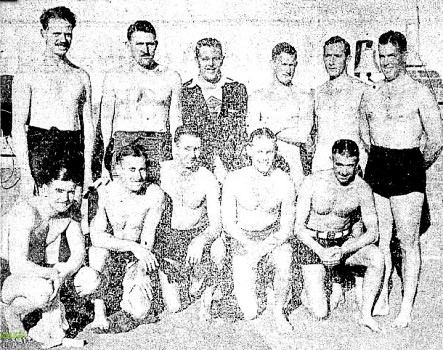
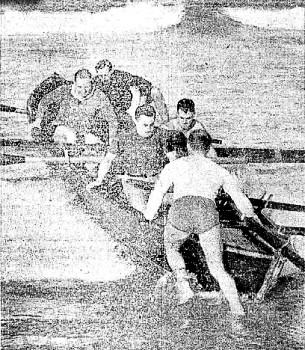
|
Newcastle Morning Herald and Miners' Advocate
16 June 1939, page 29.
SPORTS CHATTER
(By "THE ONLOOKER ")
THERE ARE high hopes in Australia that the surf team soon to
leave for Honolulu to compete in the Pacific Ocean Games will
return with victories in every important event.
If it does, the team will have conquered strange conditions as
well as skilled opponents
The surf at the famous Waikiki Beach is much different to the
surf on Australian beaches.
It will be remembered that famous Hawaiian swimmers visiting
Australia, and skilled in the use of surf-boards, had to
practise for a long time before they showed skill equal with
Australians in the surf here.
The surf at Waikiki is given the name only as a courtesy title.
It is possible to wade for more than half-mils from the beach,
with the result that breakers are very small when that point is
reached.
They become smaller on their way to the beach.
The speed of the breakers is low compared to the rollers on
Australian beaches.
Such conditions would have suited Newbiggin, and he will be
missed.
Trove
1939 'SPORTS CHATTER', Newcastle
Morning Herald and Miners' Advocate (NSW : 1876 - 1954) , 16 June,
p. 29. , viewed 23 Aug 2016, http://nla.gov.au/nla.news-article134182888
Referee
Sydney, 22 June 1939, page 17.
Stretched
Himself 1½ in Season
ON Friday, from Sydney, sails Australia's team of surf champions
bound for the Pan-Pacific natatorial meet.
Fifteen strong, silent sheiks of the golden sands, plus
manager-cum-captain-cum-instructor, John Cameron, and official
coach and swim mentor, Harry nay, sail the tropics as the
greatest 'show on earth,' as Barnum would have said.
Fourteen of the team can be classed as the
chorus-cum-ballet-cum-sideshow support of one named Robin
Biddulph, who at the
present time seems classed as Australia's best bet for Helsinki
Olympiad.
Now young Robin Biddulph is billed to meet the best of his class
from the United States, Hawaii, and England, and the test should
prove whether hopes should be pinned oifhim for Finland.
The rest are supports as far as the water carnival is concerned.
Biddulph has developed into a second Johnny Weissmuller.
During the past swim season he has stretched himself one and a
half inches and now measures 6 feet 2½ inches
in height, and weighs around the 15 stone 4lb. mark.
That's not all, and it's not likely, to be, for young Biddulph
has the reputation of being the greatest eater Australia has
seen for years.
Lord help Hawaii and their pineapples.
Jokes aside, when this team hits Honolulu, I don't know, who
will be the most surprised, the team or the Hawaiian
authorities.
As far as tlie Australians are concerned they will be greeted by
famed Waikiki, which will have to be on its best behaviour to
provide a sea that could equal our surf only on a strong
westerly day.
As far as body shooting is concerned, well, our boys can forget
all about it unless there happens to be a tidal wave.
As a carnival show they will be good.
Good enough, anyrate, for the many folks and organisations that
are using an amateur association as a commercial publicity
racket.
Here's wishing their success and plain sailing.
Trove
1939 'Stretched Himself 1½ in
Season', Referee (Sydney, NSW : 1886 - 1939), 22 June, p. 17. ,
viewed 23 Aug 2016,
http://nla.gov.au/nla.news-article127607846
The Telegraph
Brisbane, 11 July 1939, page 22.
Australian Life
Savers Thrill Hawaiian Crowd
Quite at Home in 'Dangerous' Koko Head
Breakers
By Phil Wynter, special Representative of
"The Telegraph."
HONOLULU, July 10.
Fifteen thousand people drove 15 miles from Honolulu to watch
the Australian surf team in an exhibition at -Koko Head ocean
beach to-day.
The crowd screamed with excitement as the surf boat crew rode
the choppy medium sized waves.
They were the first real breakers that the Australians had
experienced here.
The waves at Waikiki have been only a foot. high, reminding the
team of Sydney's harbour bound Balmoral beach on a windless day.
Themselves disappointed by the quiet surf, the Hawalians this
morning prayed to the native gods to whip It up.
Coincidentally the wind rose bringing up bigger waves.
Hawalians Warn
Australians.
The Hawaiians warned the Australians against taking their surf
boards and boats into the surf at Koko Head because they thought
it was too rough.
In their element at the sight of good surf, however, the
Australians staged a carnival like those they have become used
to at home.
They gave a rescue and resuscitation demonstration and then
indulged in belt racing, board riding, and surf racing among
themselves.
The huge crowd was spellbound at first and then continued to
shout their delight at their first sight of Australian surf life
saving activities.
|
Biddulph
Prepares.
Robin Biddulph has an extensive dally training routine
for his 800 metres clash on Wednesday with Bob Pirie
(Canada) and Paul Wolfe (U.S.A.).
Plrie won the British Empire Games 110 yards and 100
yards titles in Sydney last year, defeating Bob
Lievers (England) and Blddulph.
Wolfe Is from the University of Southern California
and this year won the American National 100 metres
title and was sent by the University to Honolulu
instead of Ralph Flanagan.
He stars at all distances as does Pirle.
The second swimming carnival in which Blddulph will
compete is on Friday and the third on July 19.
The Australians will compete in surf boat and surf
board races against the Hawaiians and Americans in
still water on Sunday, July 16.
The monster surf carnival which Is exciting intense
interest will be held on Saturday, July 22.
Even in Honolulu,
the home of surf-boat riding,
Australian exponents thrilled
spectators with their work in "choppy" surf.
|
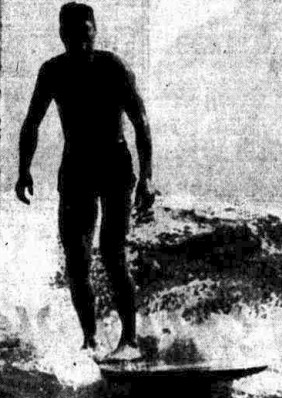
|
Trove
1939 'Australian Life Savers Thrill Hawaiian
Crowd', The Telegraph (Brisbane, Qld. : 1872 - 1947), 11 July, p.
22. (SECOND EDITION), viewed 23 Aug 2016,
http://nla.gov.au/nla.news-article188593482
The Telegraph
Brisbane, 12 July 1939, page 2.
Biddulph's Team Beats Nakama's in Record
Time
Pirie
Swims 220 Yards in 2-13 2/5
By Phil Wynter, special representative, of "
The Telegraph."
HONOLULU- July 11.
Robin Biddulph, a member of (he Australian surf, team, swam an
excellent 220 yards to-night in the baths.
He was a member of a team which broke the American record for a
four by 220 yard relay race.
Biddulph
swam his 220 m 2 mins. lb secs.
The other members of his team were Bob Pirie (Canada), Paul
Wolfe (U.S.A.). and Pete Powlison, an American born Hawaiian.
Their times were Pirie (2.13 2'f>). Wolfe (2.19). Powlison
<2.19).
. iW total time, Y mins. 0 2/5 sees,
clipped fO 3/5 sees, off the American
record,' and 0 3/5 sees, off the Empirr
Gnnies 'record, established by England's
four.
The world's record is 8 mins 58 'sees.
Defeated Naknina's
Team.
The composite team easily beat a Hawaiian
team, consisting of K. Nakaina (2.15 -2'5>. Hirosc (2.19J).
Ben
Tor 2.241). Josc Bnhnorcs 2.251).' BiH-
clulph will meet all these swimmers in
the ShO metres event to-morrow night;
Hnlf-mile Shiicits.
The Australian surfers had their first experience of big waves
at Waikiki.
The surf-boat crew thrilled the crowd by shooting in for half-a
mile.
L. Morath, the boardman, earned the praise of the Hawaiian beach
boys, by catching waves farther out than the local champions.
The crowd outside the Royal Hotel made the reel squad give many
encores of their drill and later the Australians surfed.
They shot waves on the body from 400 yards out.
"They're good," was the comment of one- local surfer, who tried
but failed to emulate the feat.
The Australians consider they will put up a good showing in the
big surf carnival on July 22.
Trove
1939 'Biddulph's Team Beats Nakama's in Record Time', The
Telegraph (Brisbane, Qld. : 1872 - 1947), 12 July, p. 2. (SECOND
EDITION), viewed 22 Aug 2016,
http://nla.gov.au/nla.news-article188598849
Barrier
Miner
Broken Hill, NSW, 13 July 1939, page 3.
SEA DRAMA AT WAIKIKI
Surf Captain In Rescue
HONOLULU, July 12.
JACK CAMERON, captain of the Australian surf team now in
Hawaii, was able to give ΰ practical demonstration of Australian
life saving methods when he rescued two women
from the surf today.
Cameron was paddling on his surf-board 500 yards from
Waikiki beach when he heard the cries of two women struggling in
the surf.
They were exhausted after having been thrown
from their surfboards.
Cameron was able to take both women to the beach.
The Australian team has been invited by Mr. Christian
Holmes, a millionaire, to spend a day at his home
on Coconut Island, where an
elephant, imported from the Berlin Zoo, roams the garden.
Also in the garden is a giant tank full of
fish.
Forty fishing rods are provided for the
guests.
Mr. Holmes. also has a hothouse containing. 25,000 orchids,
and refrigerators in all sorts of places so that
cold liquor may be had at any time
and any place.
Trove
1939 'SEA DRAMA AT WAIKIKI', Barrier Miner (Broken Hill, NSW :
1888 - 1954), 13 July, p. 3. (HOME EDITION), viewed 23 Aug 2016, http://nla.gov.au/nla.news-article48321879
The
Telegraph
Brisbane, 13 July 1939, page 1.
Australian Lifesaver
Rescues Two Surfers At Famous Waikiki
While the Australian lifesaving team is in Honolulu chiefly
for competitive and demonstration purposes, its
captain-Instructor, Mr. Jack Cameron, was called upon yesterday
to show some practical work in rescuing two girls, 500 yards
from the beach at Waikiki.
Although one of the best exponents of orthodox lifcsaving
in Australia, Jack Cameron saved his two patients by common
sense methods that are not in the handbook.
The Australians have been invited to visit the palatial and
fantastic home of millionaire Christian Holmes.
Full story on page 3.
Trove
1939 'Australian Lifesaver Rescues Two Surfers At Famous Waikiki',
The Telegraph (Brisbane, Qld. : 1872 - 1947), 13 July, p. 1. ,
viewed 23 Aug 2016,
http://nla.gov.au/nla.news-article188601274
The
Telegraph
Brisbane, 13 July 1939, page 3.
Australian Life-Saver
Rescues Two Girls
Team To Be Guests of Millionaire
Playboy at Fantastic Island Home
By Phil Wynter, Special Representative of " The Telegraph."
HONOLULU, July 12.
Two women were rescued in an exhausted condition by Mr.
Jack Cameron, the captain-instructor of the Australian surf
team, in the surf
at Waikiki this morning.
Jack Cameron was paddling a surfboard about 500 yards from
the beach at Waikiki when he heard cries for help, and
found two women
floundering exhausted and unnoticed.
They had fallen off their boards which had been washed
away from them.
Jack Cameron helped them on to 'his own board and then
paddled them ashore.
Trove
1939 'Australian Life Saver Rescues Two Girls', The Telegraph
(Brisbane, Qld. : 1872 - 1947), 13 July, p. 3. , viewed 23 Aug
2016, http://nla.gov.au/nla.news-article188601552
The
Telegraph
Brisbane, 15 July 1939, page 7.
"Ginger" Rogers
Rows With the Australian Life Saving Boat Crew
Movie Star Lured from Retirement By Team's
Display
By PHIL WYNTER,
Special Representative of "The Telegraph."
HONOLULU, July 14.
"Ginger" Rogers, Hollywood film star, who had been "in smoke"
since her arrival in Honolulu two days ago, was lured out to-day
by the Australian surf team's display.
She took an oar in the surf boat and "cracked' Wakikik waves all
day.
Arriving on the Lurline for a holiday Miss Rogers dodged
reporters and photographers and got ashore unrecognised by
wearing dark glasses and a wig.
She secreted herself in a luxury suite at the Royal Hawaiian
Hotel, overlooking Waikiki Beach.
This morning, from her verandah, she saw the Australian surf
boat crew F. C. Davis. J. B. Harkness, R. A- Dickson, F. N.
Braund and W. A. R. Mackney grouped beside the boat
Who Are You Guys ?
"Hello, who are you guys?" asked Miss Rogers,
walking up to them.
All hastened to explain that they were from Australia.
"Say, will you take me out In your boat?" she asked.
The boat could not have been launched quicker for an emergency
rescue.
The dancing, singing film star rode three waves, each from
halt-a-mile out. shouting with glee.
Throughout she sat beside Constable Wal Mackney, helping to pull
his oar.
Out After Lunch
Miss Rogers, after luncheon, again spent
the afternoon with the. crew in the boat
She has promised to travel with the team in its. motor
coach to the swimming baths for to-morrow night's
carnival.
Trove
1939 '"Ginger" Rogers Rows With the Australian Life Saving Boat
Crew', The Telegraph (Brisbane, Qld. : 1872 - 1947), 15 July, p.
7. (SECOND EDITION), viewed 23 Aug 2016,
http://nla.gov.au/nla.news-article188596725
The Sydney Morning Herald
18 July 1939, page 15.
SURFBOARD WINS.
Australian Team in Honolulu.
OPEN-WATER CARNIVAL.
HONOLULU July 16 (A AD
Members of the Australian surf team competed in an open-water
carnival.
Surfboard men won two events.
R. K. Russell (Palm Beach), L .Morath (Manly), C. R. Chapple
(North Bondi), and L. Borman comprised the Australian team which
won the mile surfboard relay for teams of four.
The Australians were in a seemingly hopeless position against
two Honolulu teams, but made up their leeway and won by 40
yards.
The Australians also won the surfboard race over three-quarters
of a mile by 20 yards from a local crew.
Jack May (Honolulu) won the half-mile surfboard race by 30 yards
from Russell, with Chapple third.
In an open-water half-mile race, K. Nakaina (Honolulu) beat H.
R. Biddulph (Australia) by 20 yards in 12m 40.5s, after Biddulph
had
led at the three-quarter mark.
P. Powlison (Honolulu) was third, Hirosi (Maul) fourth, and R.
Pirie (Canada) fifth.
There were 17 events.
The Australians did not take part in other contests.
There were at least 5,000 spectators.
Trove
1939 'SUREBOARD WINS.', The Sydney
Morning Herald (NSW : 1842 - 1954), 18 July, p. 15. , viewed 22
Aug 2016,
http://nla.gov.au/nla.news-article17607043
The Telegraph
Brisbane, 18 July 1939, page 3.
Biddulph
Lost in Half Mile Swim.
Stops to Ask Way in Honolulu
Games Event
Special
Representative of "The
Telegraph."
In the third carnival
of the Pacific Games
series, Robin Biddulph
(Australia) in the half
mile open water swim was beaten by Kiyoshi Nakama (Hawaii).
Biddulph, who led
early, stopped three
times during the race,
once to inquire his way from a launch, once to find his bearings and once when he mistook the finishing line.
Australia won the
three-quarter mile
surfboat race and the mile surboard relay.
Russell (Australia) was second in the three-quarter mile open surf board race, and Biddulph (Australia) was second in the half-mile open water swim.
The races were all
conducted in the
Alamoanna Canal.
Australia went to the
front at the start of
the surfboat event and were two lengths ahead at half way.
The Hawaiians finished, raggedly three lengths to the bad.
Australia's time was 6 rnins. 57 7/10 secs.
Australia's winning surfboard relay team, comprised Chapple, Boorman, Morath and Russell.
Hawaiia's No.1 team finished' second, 30 yards behind, and the No. 2 team was a further 60 yards back.
Australia's win was
due to Russell, who in
the last lap recovered
a leeway of 20 yards and forged right away over the final 100 yards.
The time was 10
minutes 49 seconds.
Jack May, an American!
living in Honolulu, won
the open surfboard
event by 20 yards from Russell, in 6 mins. 53 9/10 secs.
He paddled a most elaborate board equipped with a compass and a rudder.
Biddulph dashed away
at the start of the
half mile swim and at the halfway mark, was 60 yards ahead of Nakama, Plrie, Hirose, Powlison and Wolfe.
From then on he was
forced to stop three
times, once to ask his way
from a launch, once to locate his bearings, and a third. time when his mistook the finishing line.
He swam in mid-channel against the tide while the rest of the field stayed inshore in the lee.
Nakama passed Biddulph
in the final stages and
won by 30 yards in 12
mins. 401 secs
Biddulph's time was 13 mins. 41 secs.
Powlison was third, Hirose fourth and Pirie fifth.
Biddulph finished
fresh, but the others
were exhausted.
Biddulph will swim in
100, 200 and 500 metres events in a 25 yard pool on Wednesday.
Australian Carnival Next
The surf team will next appear in an Australian style surf carnival, at Waikiki
beach on Saturday, which
will be broadcast over the N.B.C. network throughout America.
HALF-MILE OPEN WATER
SWIM.
K. Nakama (Hawaii).
12.40V? 1
R. Biddulph
(Australia) 13.4V& .. .. 2
P. Powlson (Hawaii)
. .. .. ' 3
T. Hirosi (Maul) «, ..
<4
R. Plrle (Canada) ..
.. ., 8
HALF-MILE SURF BOARD
RACE.
R. K. Russell
(Australia) 2.
R. Chapple (Australia)
3.
Hawaii No. 2 ... 3
Trove
1939 'Biddulph Lost in Half Mile Swim', The Telegraph
(Brisbane, Qld. : 1872 - 1947), 18 July, p. 3. (CITY FINAL
LAST MINUTE NEWS), viewed 22 Aug 2016,
http://nla.gov.au/nla.news-article188589108
The
Telegraph
Brisbane, 24 July 1939, page 3.
Honolulu Crowds Cause
Curtailment Of Final Pacific Games Carnival
Thousands Thrilled By Australian
March Past And R. and R. Demonstration
By PHIL WYNTER
Special Representative of "The
Telegraph"
HONOLULU. July 23.
The Australian surf team concluded its Honolulu
Pacific Games visit with a monster surf carnival at
Waikiki beach yesterday afternoon.
The Australian style programme had to be curtailed
as thousands of spectators over flowed on to the narrow
beach, crowding out the competitors.
The milling thousands swarmed around the Australians
cheering and applauding as they gave a characteristic
march past
display.
It was a unique spectacle at Waikiki with the life savers
wearing green and gold costumes and caps and
carrying their banner and reel.
The rescue and resuscitation squad drilled with
machine like precision as the huge crowd fought around
them for better vantage points.
Unable to clear the people from the beach the officials
ran only half of the scheduled programme.
Australia defeated Hawaii in the one mile surf boat
race.
The crew was F. C. Davis (sweep), J. B. Harkness
(stroke), R. A. Dickson (3), F. N. Braund (2), W. A. R.
Mackney (bow).
They gained the victory only by holding a wave which
broke a quarter of a mile from the beach and shooting
it to the shore.
HAWAIIANS' SURPRISING SKILL.
The Hawiians surprised by leading by two lengths rounding
the buoys after the half mile row out.
They finished only a length behind the Australians.
The race was practically a straightout row as the
surf was the flattest experienced at Waikiki.
The wave the Australians caught was small and slow
running and they still had to continue rowing.
SURF BOARD RACE TO
HAWAIIAN'S.
Hawaii won, the one-mile surf board race, using the
Hawaiian short paddle boards 12 feet long.
Competitors drew lots for the boards.
The Australians were well up with the leaders at the
finish and Dick Chappie gained third place.
It was won by A. Love (Hawaii) from T. Kiakona (Hawaii).
The Australians, R. Chapple, J. L. D. McKay, A.
Fitzgerald, and W. A. R. Mackney, defeated Hawaii in a
beach relay race.
The crowd marvelled at the speed of the giants- McKay and
Mackney.
R. K. ("Blue") Russell finished second in a special
unrestricted surf board race against 10 Hawaiians.
Long hollow boards were used and the race was won
by G. Smith (Hawaii) from R. K. Russell (Australia) and
A. Love (Hawaii). Russell was level with Smith 200
yards from the shore, but he lost 15 yards in avoiding
fouling him.
TEAM SAILS TO-MORROW.
The teams programme has now finished except for an
all-day Hawaiian feast to-day, at which pigs are roasted
in the ground.
The team sails from Honolulu for Australia to-morrow.
[Photograph]
The spectacular march past thrilled
Hawaiian crowds at the final carnival of the Pacific Games.
Trove
1939 'Honolulu Crowds Cause Curtailment Of Final Pacific Games
Carnival', The Telegraph (Brisbane, Qld. : 1872 - 1947), 24 July,
p. 3. (CITY FINAL LAST MINUTE NEWS), viewed 23 Aug 2016,
http://nla.gov.au/nla.news-article188598244
The Sydney
Morning Herald
24 July 1939, page 15.
AUSTRALIAN SURFERS
Waikiki Boat Race Win.
HONOLULU, July 22. (A.A.P.)
The surfboat race was the feature of the
aquatic carnival today on Waikiki Beach which was the concluding
event in the Australian surf teams visit.
The distance was a mile and after a close struggle the Australian
crew beat the Hawaiians by a Iength.
In the surfboard race of a mile, R. K. Russell of Australia
was forced to swerve near the finish to
avoid colliding with an opponent.
Russell finished second to George Smith
(Honolulu).
In a second surfboard race the Hawaiians far
outdistanced the Australians C. R. Chapple
(fourth) F. Borman (fifth) and
L Morath (sixth).
Trove
1939 'AUSTRALIAN SURFERS.', The Sydney Morning Herald (NSW : 1842
- 1954), 24 July, p. 15. , viewed 23 Aug 2016,
http://nla.gov.au/nla.news-article17596068
Newcastle
Morning Herald and Miners' Advocate
12 August 1939, page 7.
AUSTRALIANS IN
"ROUGH" SURF
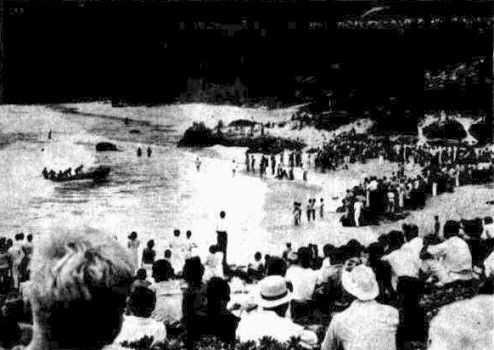
The Australian surf-boat crew amrazes a crowd of
15,000 people in the "'rough" surf at Koko Head Beach, near
Honolulu.
"I'M GOING BACK.SOME DAY"
HECTOR SCOTT ENTHUSES ABOUT "HONOLULU"
(By "Corinthian.")
MR, HECTOR. SCOTT, the Newcastle memnber of the Australian surf
team which visited Honolulu, returned lhis week convinced that
Honoululu is the finest place in the world in which to live.
"Three members of the team got off the boat when we were leaving
and reconsidered whether tilhey would go," said Mr. Scott,
"Practically all of us are going bsck as soon as we can.
"Our lifesaving methods were a revolation to them, and they have
formed a life-saving association," said Mr. Scott, who also
described a meeting with Ginger Rogers, the flim star.
"Disappointed in Honolulul?' asked Mr. Scott.
"Why, it's perfect.
I went to New Zealand with the Australian surf team in 1937 and
it's not a patch on Honolulu.
Houolulu is a fiuoseli tipgi pince, and just as beautiful as it's
re ported to be.
You ought to see Wailiki Beachl with 200 surf boards and canoes;
floating on the water and shooting the green waves.
The waves, which start to break aboult a mile off the sahore, are
breaking slightly ,all the way in.
They are not so good for bodly shooting.
Theres not enough power in them.
I went 200 yards on otle one day but that was unusual.
People don't botlhier about body shooting there, you have to swim
a mile out to 'crack' a wave.
"l've lever seen so many surfboards.
In an oatrigger club I counted 100 boards in one Iccli, and there
are dozens of na.cl;.
I suppose there would be 2000 to 31100 boardn at the beach.
Many people stay near the edge as they do here,but most of tlhem
go out on boards.
Nobody ever gives sharks a thought.
Sharks can got iI over the reef-don't nmak any nmis takn anout
tlnt--but 'nobody has ever been taken.
You worry imore about hifs conger.eels which are in the coral than
about shark.
The sand is so hot you wear whlite shoes so your feet won't be
burnt, andl you wear them in the water to protect you from the
coral
"The boards are at least four inches thick--much thicker than
ours- and some are 15 feet long but they're as light is a feather,
boys five and six years old and young girls ride the waves on.
boards,
'lierR are so inlaiy .boards and canoes that they otrilte each
oilier at times.
You often see outrigger canoes coming in with six or seven peolle
in each one.
People on boards keep out of their way.
Everybody in tile canoe has a .paddle.
There is an Hawaiian steerman and anotlher in the middlle of the
canoe.
Tourists pay two dollars each for tlhree trills in these canoes.
White women egage natives to take tlhem out on boards and they
come in on a wave on the natives' shoulders.
Lifeguards in Water
"Their ideas of life-saving are comparitively primitive, there are
no surf clubs like ours, Lifeguards are on duty only
stond 1s0 yards out in the water.
Most of the rescues are done witlh boards.
If a nlm weroe llnder tlio water for 10 minutes they would never.
bring hint sound.
They don't know much about resusclation; our workl was an
eyeopener to them.
"They have formed a life.saving association snsd ruo going
to form clubs and follow the handbook of the Surt Life.saving.
Association of Aiustralia.
"No method of transpart was provided
. Kok Heoad lieaeh, where rwe gve o0110
lisplny, but 15,090 people nrr'ivedt In
atorcnara, E]veryblody in Honolultu hlis
..ear, voaen lftboys insd paporhoyS. Potarol
Is "lcclp, ond st treeadnl cost only foullr'
lhillings. We were told tlhat the surf
vnas ,rough, blt we showed tlhenm it w1as
inly molderate. We went through it with
nml without bell, on boards andll in tlhe
ont andl they were anlazed. Wo gave
wo or thiro reseC and rosuscitatint
isplays n nd tle boat 'crackedl' a shoot
v l out and camn rsight In, Tile dso
ighted crowd rushed down the boealh,
iurronsled the boys and a ,would not let
hemn como out of the water until. they
lad dono it again, 'The crowd was still
tanding roundl after it was nall over. That
leachl isn't as big as Nobbys, .wo people
vora: drowtned there a fQw" vo'arl ago,
That's why we. went there. There'S no
lifeguard tlhere althouglh a lot ofl people
swil thele.
"Thle sandi on their beaches is durlker
and not as. fine as ours, WThella tile tide
is in. Waikik.iBelLch is not moe thaIun
O20ft. wide. They pulled outrigger club
sheds down and hare artifieially widened
thile beach.
V'I saw Ginger RoIgers on the beach
on daRy and went up and i(trldcede
mlyself. Slhe was r'ery ftriecllJy. W'hen. tihe
boys saw whom I was withl thley deishled
up and sroundd 5raRd he'Ir. She has a cliarm.
ing persoallllity bult siah's not thle girl
you soee on. the sclreen. I-cr hair is
ginger all right. Sile is not i3 the 8same1
c?ass as asmany Austrnlinn girls. Al Jol
son's wife, l3uby Keeler, however, is
.enutiful. Ginger Rogers always (wel
conaed the boys, and they were the only
iele silhe woulld penk to el thle tele.
phone.l ,
* ,
"A Happy Family"
"The people in ionolulu are a habpy
family There are Chinese, Japanese,
Filipinoes, Hawaiian, A\melricana, . Eag.
lishmen and a few Australians. oan can
drink until midightll but yon' don't see
drunken people. They won't serve yoell
If they think von have had enough. If
you are hfiid fora dlrunkeaness the
manager of the place where you o
drunk is fined, too. The wages are 1hgh
and the working holrs short. Thd cot
of living is high, too, of cujlie. People
start work at 8.30 am, and finish at 3.40
p.m. and1 theanl srf Intil 7. Some n per
soons surf in tile moonlllillt. The averlago
girl shop assiAtant, receives aboullt 40 a
week. . ,
"Dlhio .Knhananloku n; thile sheriff of
Heonollll, is worshipped by thile people.
Iie Is prlatically king dild wloat 11e s5y1
goes. He Is ahaollt 52 bllt hlae still &
good s5willnmer lih gave anll exhibition
lt NWoieastloe yearlll ago:.
"1'' wrll trealtl wlllurleifull; we could0
ave o0110 to fl or fire partiec \roa k
Tllelroello elase distilctioll aInd no11 colour
lille. 'Tle auolltllorities provilde larks
every few m-iles for childreno, al1 thlree
or ola, ILstruletors teachlilg liwinnIIdg alnd
bull.gamIes tlhere. Tlhe parks are full of
Ioys. Pinell lel grolwillg lanld sugar.cano
are tlia nmin industries,. There are mihu
of pineapl Ilalntlatiolns conltrolledX.by
whitelo pele, ad workedl by Jopanese anld
I rilipiloes, .'1 prodllucts are sent all' over
"TheImoon isaso bright the night is like
lay. lawaiial 111s101 is 3always beingl
played, Ald eul thLr play tlMOe ellitura:
ant11 ulleliel Thley IlIlk tllel talk. T'lhere
lare no illemployel, alol1 tlhey ldonl't llow
what110 thle dlle is. At tillmea they bioadcast
from illn tile wiater and youll ea'n hear tlhe
waves lappillgoh oVi Willki Beachll. They
st-t1d upl to 'he waist inll the water with
00olinrophono, anhllaIl e anllotller micro.
phone in front. of on 1-owniian bnld on
the veralldah, 1'. Po e listenilng, in caui
Ilear'. ell solaltilng u s they come in on
boarlls.
!'You.canl't Ihelp bllg impressed with
the marveollous way tley live in 'llonolhlu.
We haIlve the righlt 'colltry, but we don'et
live the righlt vway. Look at ollr ridicu*
lolls llmcw lothesllO, for instance. Tlihey
lnever wanr collars anl nobody: dlrenser
feor'dinner, Nobody over plts thelir alirt
inildo thlir trousers. We tlhoulIht it was
funnlllly at first, bllt oon became ?sel to it.
The shirts do p te middle lll lilke1 n clnta
"11d ore Olml v lro, They ore g?y, likeg
ilifd there, 'Th0 girls wei slaunls'
Vivid Shirts and Truniks
ir.. Scott took otit vivil shis n?nd
trunks with pltlr'os of. plnthn trec, and
conoes on thbl., "'Who ~ul 1. won't weai
them?" he said. "Wait till 'it getol hot
and(( yo'll see.(0,
"We had nplileasant trip oveor nold
noliodh otly ' w , olo, M ' peop1e' n the
nhhp, iJnelnllng hrry Alc'r the famno11
noilnthorgan player, o edgiod theair plan
aond got olf nL Unnlolllhl nd follod ed the
team, h61ot, When we were in the tropico
overyhody. tIok their beds on ,lio deck.
We hld toh bole h di nt 11 o'Cloek ovary
night, anod ( exerehosi on' othe'top ok t at
0 ove), nmorninIg. T1i'e0 we nl?led slx
mnle oron11l lti dock, pingio Anatl'olin
0nige1n. We troined iII the. 1:hoa'0 maol,
Which is fiee foot doo, and0 took i hI
tnrns Ltto s?li i n a belt alttnolhledl to the
wall by oan aliitia r loe. TiOe rose0 annd
reenimitation teamnldrilled freqclentir.
"lolhin Illiddlph did very well n the
tilllnlator events at Iiannlu li,'Il wo' s In
front five yards fromn the flidih of tlhe
140 yard0, a01d .e tlolight 1ln wo. going to
win, Ido 0a0 )Ilnrron,,l Intea)t) I foot
tilme, in both races. If heo had kept to
inatllrletiosll hel. wolld Ihavoe won thle ohaon
nl ohwlln of over a lll0, Io nasn 80 yordh
ahead with lea tlhan halnf way to go, bli1
strnck the enorrent and Was heaten by 21
rordtod. K, h'nkaln, tiomJapaneoe who
visited Alotraii n reeontly, Ient hinm, Ni;
kIlnma Rwnm alonl theo wator's edge with
blls hands nlmost* touching the bottom, ,,
"Tug vit hud to come1 to )n Cil(i, 0n0)
voetai'nl we follln thit it wia tillo .to
n, Ahot tlloil the d tieioinnle 001o edonc
to the (1001) to 0e0 u1 off. We woero ontlth
orcd in loio, TlieO wore 11neying1 Hownitno
)nztaie--"loi', You, 1(w100thenrt0, Aho -
nld t(hat Iniilea ,appictls stronglv to .the
emotions, Molany people, iiloll1ling Japo.
n000 0)ll1 ChIhocO, Oe1'o eryhig?, (11)1 1)110 00
I1 of "the 0i(n lirok down00(, .Three
eioln)berl of the tleal) got off tthe hoIst,
0n0) rco?nnsdoriet welsothlrl they wntoldi go,
One toenrd a coln.
"Paul 1Wolfe, a Irl lient Am'ori ,n , who
0wimh) 100 ynrd 'in 'latn1 ti)hn Oteac,, nid
Inh Pirie onf Canadal, wl0 won te 2210
ordo, tidok oI' thoi1' olnthes on thie dook
ioed' into the lar ii r in their 11ndler.
.InaItO, and s(wam1)' a0nlt)0l a 11i) omt withl
tIle hot 11111ti the rOni(tgn( ard ship0, whloh
lo lihoe 0)nst1 dllstnoyer, ,s oploln 1:thm
111d l,hs' 000(0 hlok, ' I?n,? inlle'onclil
tUo, some .1t11, JuO nos.aoon, ao I con,"
Trove
1939 'AUSTRALIANS IN "ROUGH" SURF', Newcastle Morning Herald and
Miners' Advocate (NSW : 1876 - 1954) , 12 August, p. 7. , viewed
23 Aug 2016,
http://nla.gov.au/nla.news-article133741148
Evening
Star.
Washington, D.C., November 11, 1939, page 17.
TRAIN FOR CONTEST
Some of the entrants for the second annual national
paddleboard surfing championships, to be held at Long
Beach, Calif., December 2, shown perfecting their form
in a dry land drill under the direction of Alvin Bixler,
Pacific Coast surfing champion.
These girls, members of the Long Beach team, are
(left to right) Dorothy Fincannon, Marion Stearns, Dale
de Klyhe, Betty Lindley, Jane Walsh, Gerry Warnick,
Onalee Smith and Mary Weissker.
Wide World Photo.
Chronicling America
Evening star. [volume] (Washington, D.C.) 1854-1972,
November 11, 1939, Image 17
Image and text provided by Library of Congress,
Washington, DC
Persistent link: https://chroniclingamerica.loc.gov/lccn/sn83045462/1939-11-11/ed-1/seq-17/
|
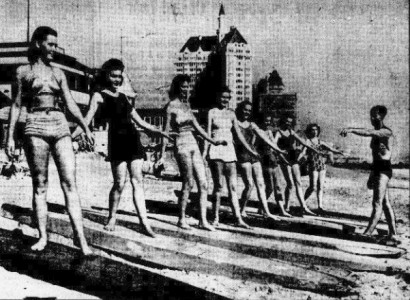
|
The Newcastle Sun
29 August 1939, page 5.
Surfing Days
Again . . .
Snow Over New Zealand
SURF
BOARDS HERE AGAIN
CROWDS FLOCKED to the
beaches yesterday, but in spite of the warm
weather, many found the water too cold for
swimming.
At any rate, it was not
too cold for this young man in football jersey,
riding in on a surfboard.
|
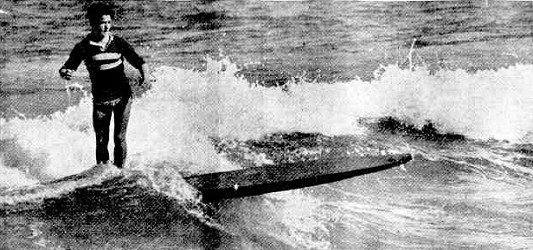
|
Trove
1939 'Surfing Days Again . . .Snow Over New Zealand', The
Newcastle Sun (NSW : 1918 - 1954), 29 August, p. 5. , viewed
23 Aug 2016,
http://nla.gov.au/nla.news-article167328155
The Sydney
Morning Herald
Monday 18 December 1939, page 4.
ROUND THE
TOWN.
BY PATRICIA PENN.
OUT of the blue so to speak comes news of Blue Russell s
engagement to Nancy Heinz, heiress to the canning millions (57
different varieties so the labels say).
The official announcement appears elsewhere on this page.
Blue met his future bride in Honolulu where she was
spending the summer vacation and he was a member of the Australian
surf team.
Maybe his prowess on the surf boards had something to do
with the romance and maybe the meeting was responsible for his
journeying to the United States from Honolulu.
One of the most versatile men in Sydney, 'Blues' activities
have included running a dress shop, working a pneumatic drill on
the roads and wool buying.
He is always recognisable in the surf because he wears a
green felt hat as he gets so seriously sunburnt.
Notes
Announcement of Russell-Heinz engagement and some brief career
details.
The Age
Melbourne, 28 December 1939, page 9.
BRILLIANT
SUNSHINE BRINGS HOLIDAY MAKERS OUT OF DOORS
The
envy of those who had to return to work yesterday were those
fortunate people who stayed by the seaside.
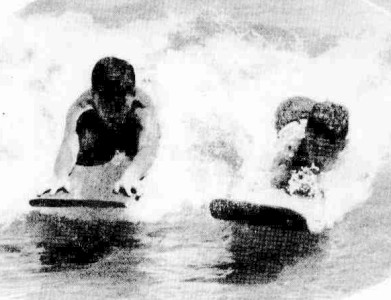 Austin Tobe and David Deans
shooting the breakers.
Austin Tobe and David Deans
shooting the breakers.
RIGHT:
Misses Allie Hamilton and Lesley Bell carrying their
surf boards to the sea at Portsea. |
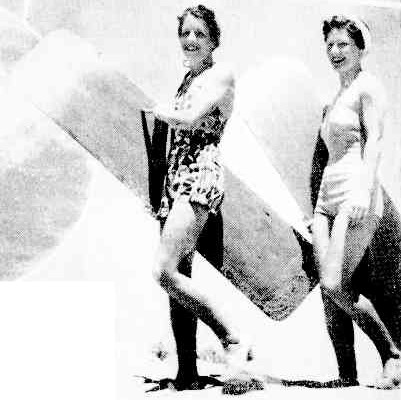 |
Trove
1939 'BRILLIANT SUNSHINE BRINGS HOLIDAY MAKERS OUT OF DOORS', The
Age (Melbourne, Vic. : 1854 - 1954), 28 December, p. 9. ,
viewed 23 Aug 2016,
http://nla.gov.au/nla.news-article205592072

surfresearch.com.au
Geoff Cater (2008-2016) :
Newspapers, 1939.
http://www.surfresearch.com.au/1939_Newspapers.html









